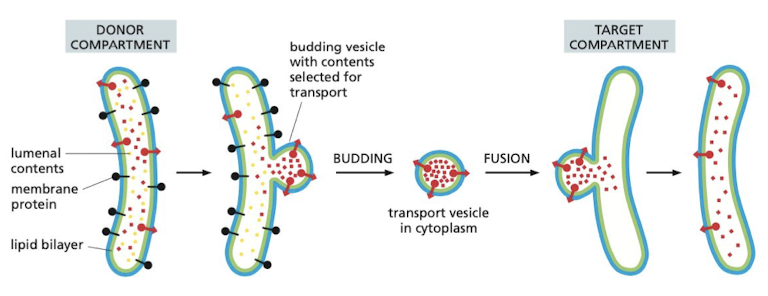CSF Exam 2 (copy)
0.0(0)
Card Sorting
1/148
Earn XP
Description and Tags
FSU Cell Structure and Function Su '23 exam 2
Study Analytics
Name | Mastery | Learn | Test | Matching | Spaced |
|---|
No study sessions yet.
149 Terms
1
New cards
What genes are expressed across all cell types?
Genes involved in common cell processes → Housekeeping Genes
2
New cards
At any one time, the typical human cell expresses what percentage of its \~25,000 genes?
30-60%
* genes expressed in each cell determines type, structure and its function
* genes expressed in each cell determines type, structure and its function
3
New cards
What method allows you to identify cell type?
mRNA sequencing
4
New cards
What are the main ways we are studying (in this class) that gene expression is regulated?
1. transcriptional control
2. mRNA degradation control
5
New cards
What is transcription initiation dependent on?
proper localization of sequence-specific DNA-binding transcription factors.

6
New cards
how are the major and minor grooves of DNA involved in transcription regulation?
Transcription regulators can read DNA nucleotides from the outside by looking at the way they are bound to the major and minor grooves
* Transcriptional proteins surface is complementary to surface features of double helix
* Transcriptional proteins surface is complementary to surface features of double helix
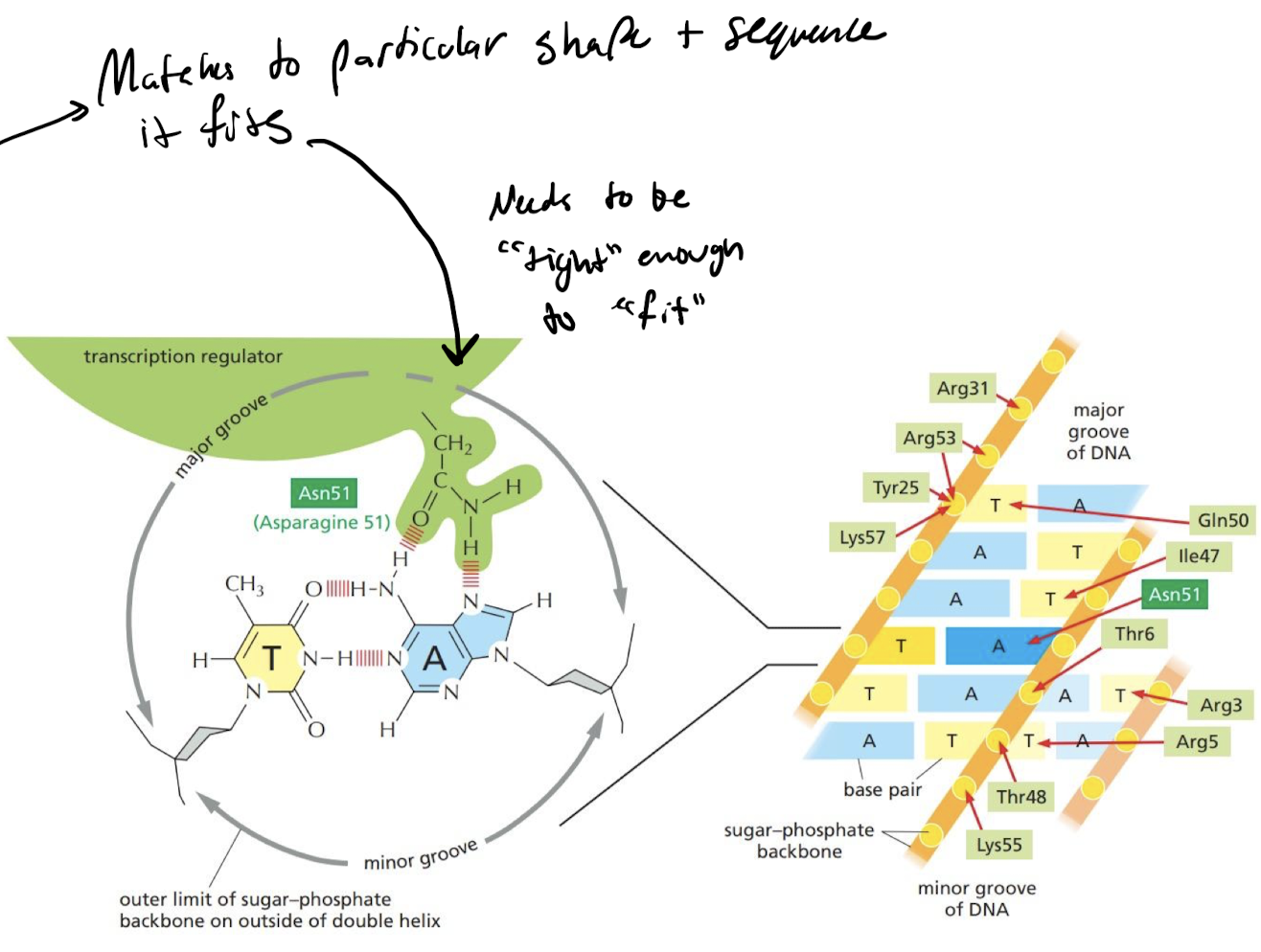
7
New cards
True or False: Transcription factors separate 2 strands of DNA to read bases.
False
* Transcription factors bind to OUTSIDE of DNA structure, no need to separate strands
* Transcription factors bind to OUTSIDE of DNA structure, no need to separate strands
8
New cards
How do transcription regulators **increase** their **affinity** and **specificity** to DNA sequences?
Dimerization = allows two transcription regulators to bind together to increase the specificity of the sequence they bind to by lengthening the sequence required by an order of magnitude
* Homodimer = two of same transcription regulator binds together
* Heterodimer = two different transcription regulators bind together
* Homodimer = two of same transcription regulator binds together
* Heterodimer = two different transcription regulators bind together
9
New cards
What are **operons** in prokaryotes?
strand of DNA with multiple coding genes together under the control of a single promoter.
* genes are transcribed together into one single mRNA strand → are generally functionally related to each other
* unique to prokaryotes
* genes are transcribed together into one single mRNA strand → are generally functionally related to each other
* unique to prokaryotes

10
New cards
What is an **operator** on the promoter region of an operon?
cis-regulatory sequence located within the promoter that allows binding of transcription regulators.
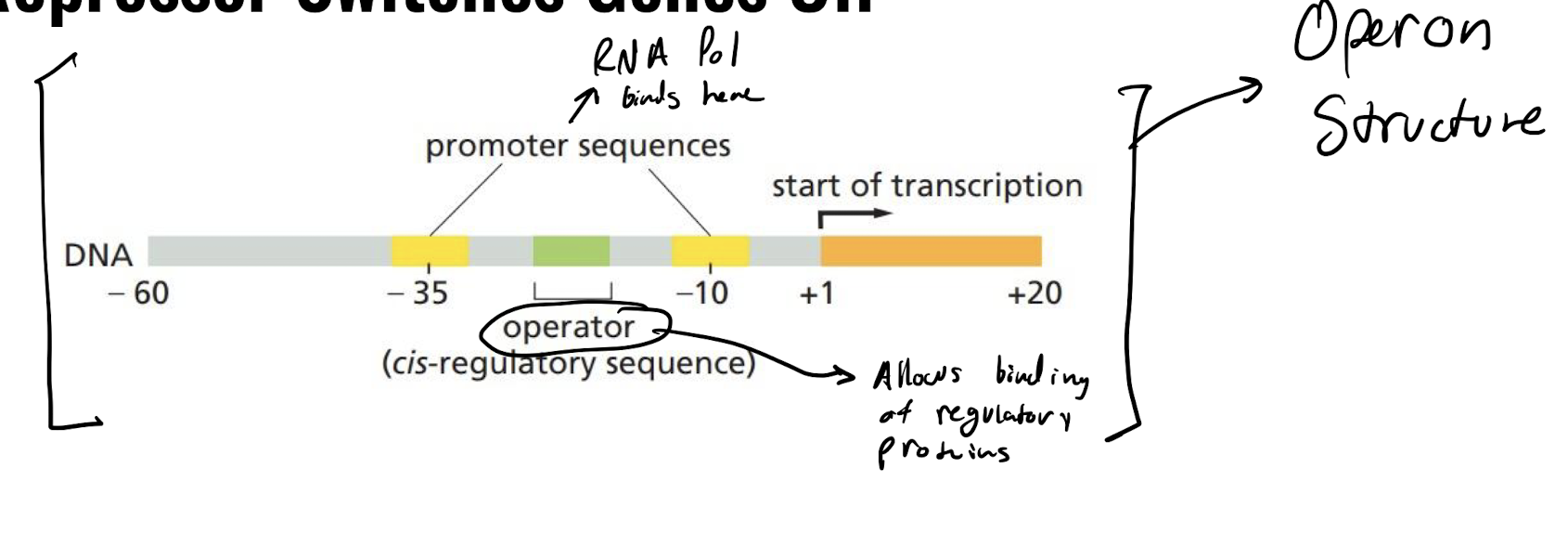
11
New cards
What is the function of repressor regulatory proteins?
Form of **negative allosteric activation** where the presence of a molecule turns off the expression of the molecule’s synthesis gene
12
New cards
What is an example of a repressor regulatory proteins?
The tryptophan operon
* Low trp concentration = operon is **ON**, trp is synthesized
* High trp concentration = trp binds to trp repressor which binds to operator binding site, turning **OFF** operon → no trp synthesized
* Low trp concentration = operon is **ON**, trp is synthesized
* High trp concentration = trp binds to trp repressor which binds to operator binding site, turning **OFF** operon → no trp synthesized
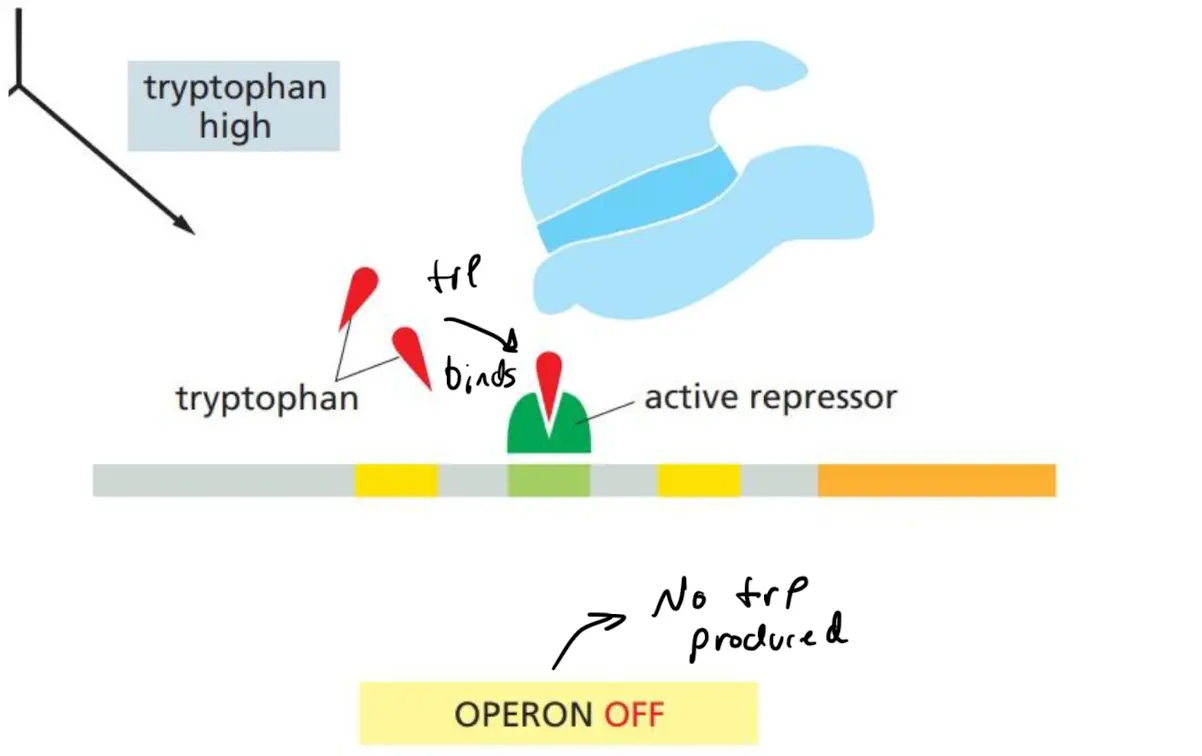
13
New cards
What is the function of the activator regulatory proteins?
Binds to cis-regulatory sequences and recruits RNA polymerase to help it initiate transcription at poorly functioning promoter
* increases rate of transcription 1000x
* increases rate of transcription 1000x
14
New cards
What is an example of an activator regulatory proteins?
Lac operon
* high glucose, high lactose → operon off
* high glucose, low lactose → lac repressor binds to operon, stops processing of lactose
* low glucose, low lactose → both activator and repressor binds to operon, no lactose is processed
* low glucose, high lactose → operon is **ON**, lactose is processed
* high glucose, high lactose → operon off
* high glucose, low lactose → lac repressor binds to operon, stops processing of lactose
* low glucose, low lactose → both activator and repressor binds to operon, no lactose is processed
* low glucose, high lactose → operon is **ON**, lactose is processed
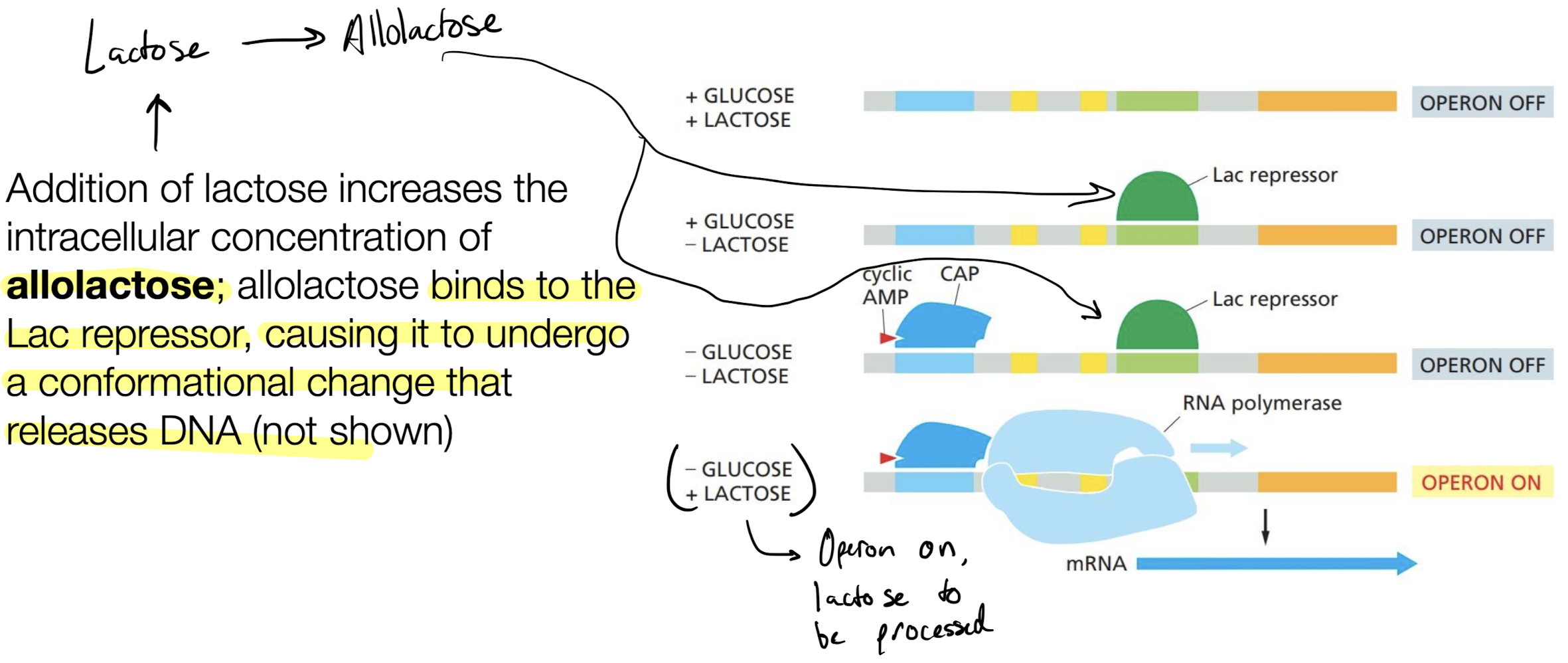
15
New cards
What **eukaryotic** control regions regulate gene expression?
**Promoter**
* allows general transcription factors and the polymerase to assemble
**cis-regulatory sequences (enhancers)**
* transcription regulators bind to control the rate of the gene activation.
* allows general transcription factors and the polymerase to assemble
**cis-regulatory sequences (enhancers)**
* transcription regulators bind to control the rate of the gene activation.
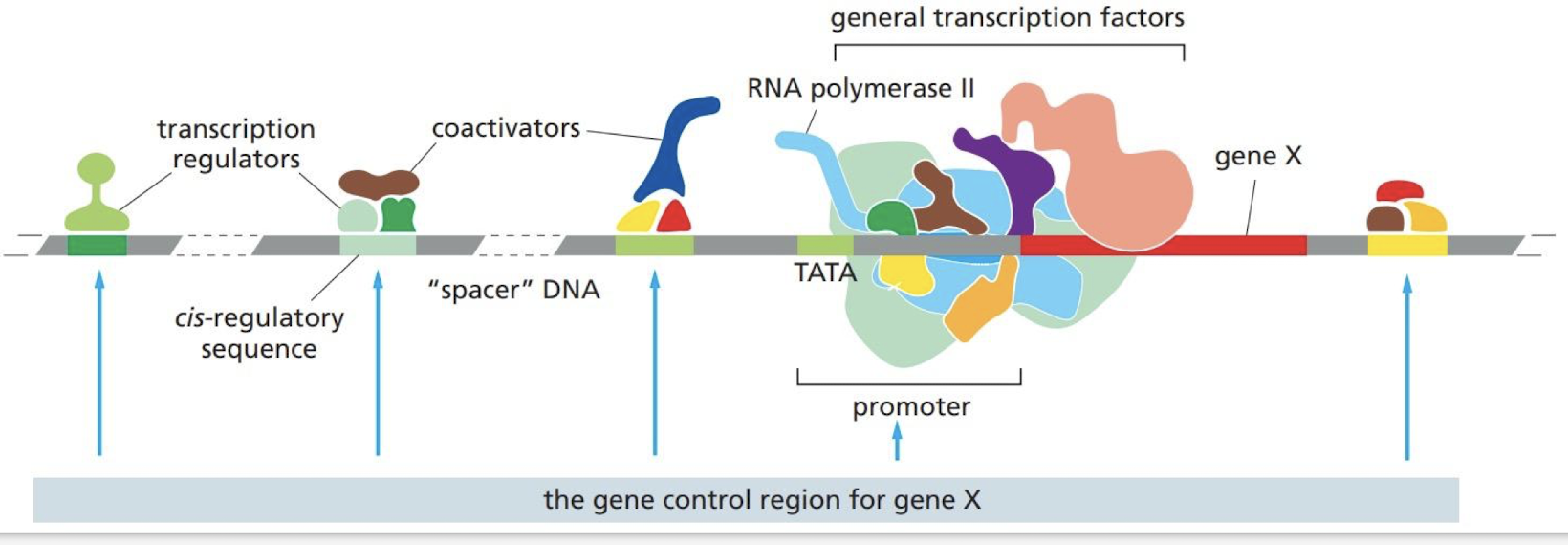
16
New cards
What allows for transcription regulators to communicate with proteins assembled at the promoter?
DNA looping

17
New cards
how do eukaryotic transcription regulators function differently than those of prokaryotes?
They assemble at cis-regulatory sequences in groups rather than individually
* some transcription regulators are interchangeable between different binding sites
* some transcription regulators are interchangeable between different binding sites
18
New cards
True or False: co-activators and co-repressors bind directly to DNA to control gene expression
False
* They bind to transcription factors that are bound to the DNA → work indirectly to DNA
* They bind to transcription factors that are bound to the DNA → work indirectly to DNA

19
New cards
What are the 4 ways that chromatin remodeling complexes work to make DNA accessible for transcription?
1. Histone remodeling → Nucleosome sliding
2. Histone removal
3. Histone replacement → histone variants
4. Specific pattern of histone modification
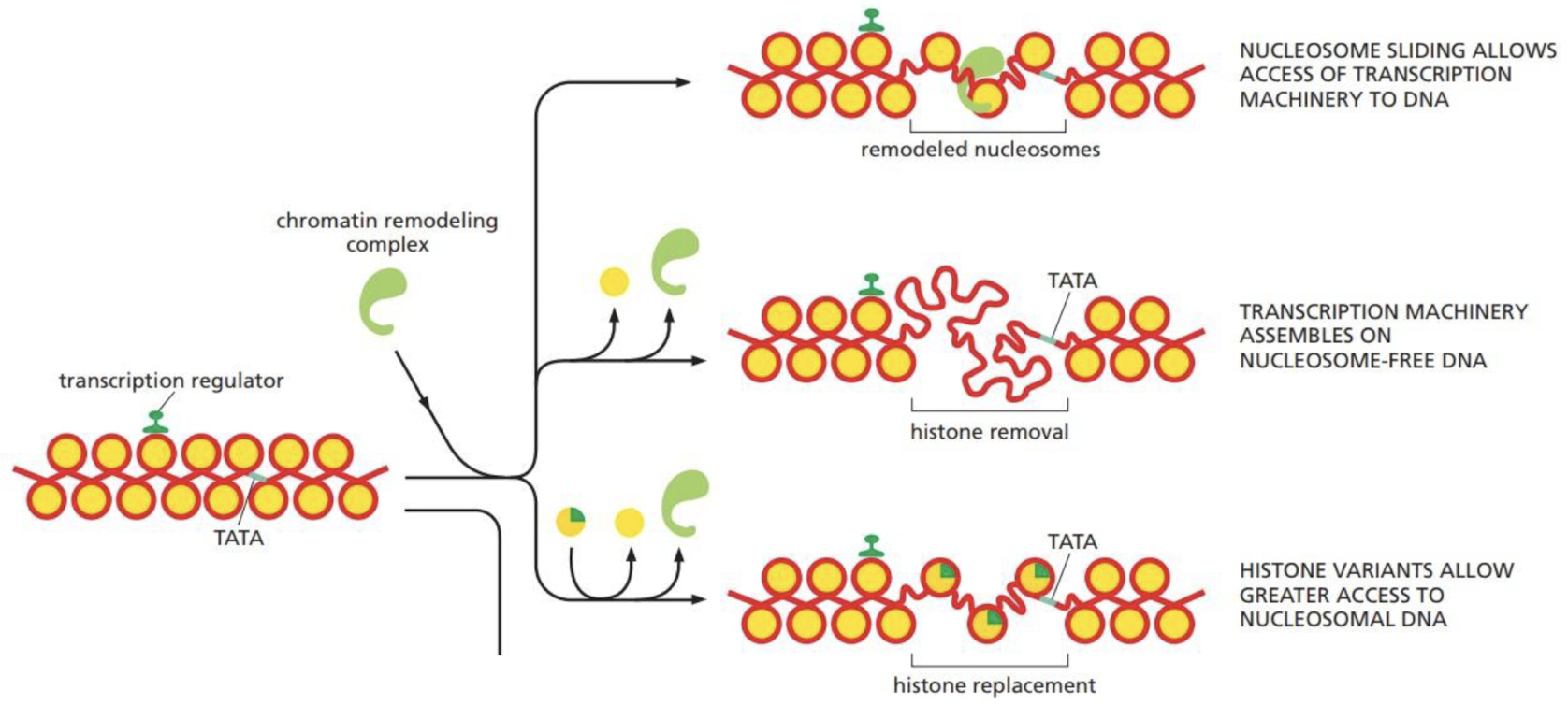
20
New cards
How are control regions of different genes kept from interfering with one another?
**Insulators**
* elements on either sides of the cis-regulatory sequence and its gene
* bind together to form a loop and stops interactions with other genes
* elements on either sides of the cis-regulatory sequence and its gene
* bind together to form a loop and stops interactions with other genes

21
New cards
How are different types of cells created?
Different combinations of transcription regulators convey different information to specify a genetic regulatory event
* ex) artificial introduction of the gene encoding the transcription regulator MyoD into fibroblasts cultured from skin tissue, the fibroblasts form muscle-like cells
* ex) artificial introduction of the gene encoding the transcription regulator MyoD into fibroblasts cultured from skin tissue, the fibroblasts form muscle-like cells
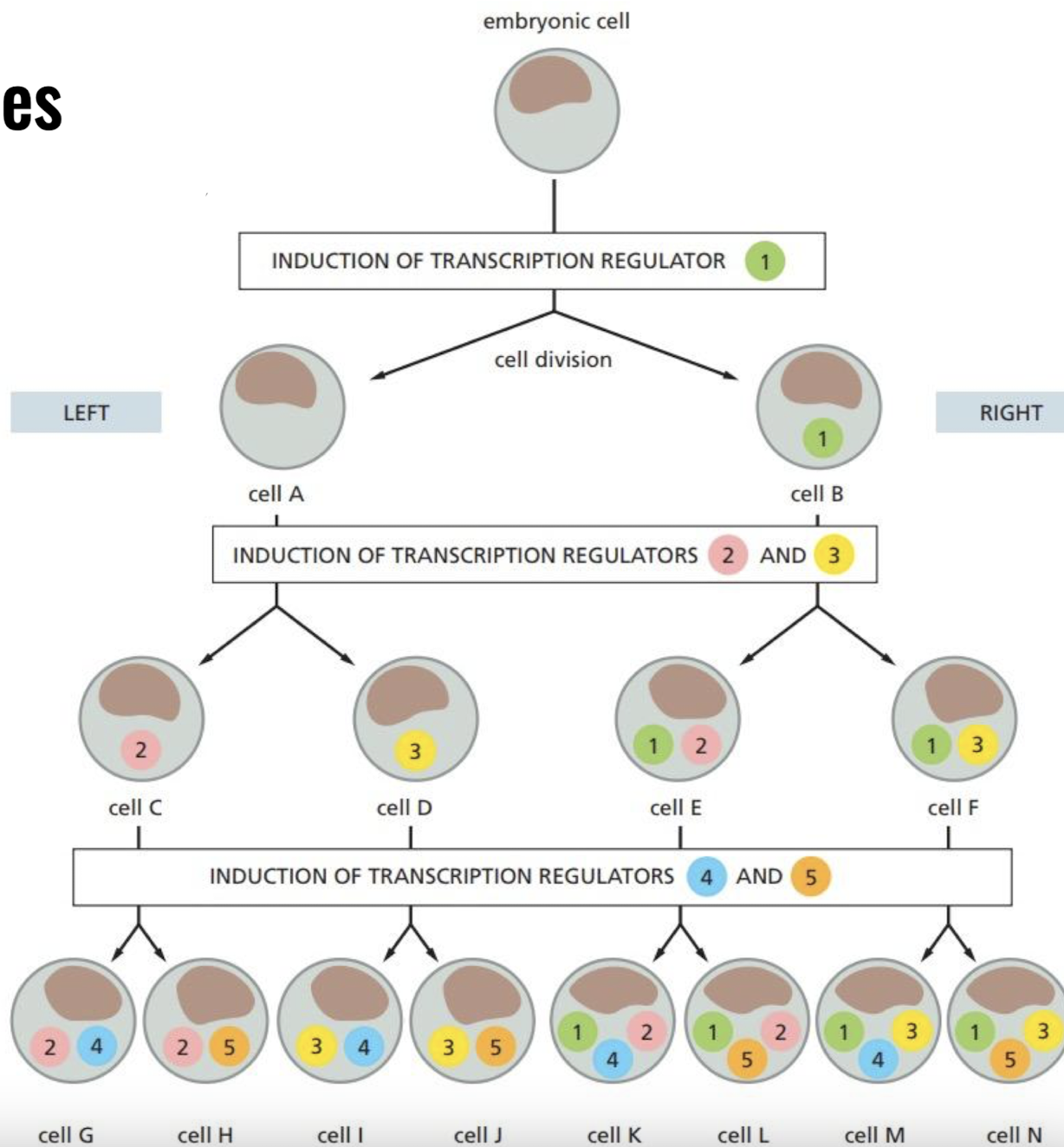
22
New cards
Can already differentiated cells be transitioned into different cell types?
Yes
* Artificial manipulation of transcription regulators can also coax various differentiated cells to de-differentiate into pluripotent stem cells that are capable of giving rise to the different cell types
* Artificial manipulation of transcription regulators can also coax various differentiated cells to de-differentiate into pluripotent stem cells that are capable of giving rise to the different cell types
23
New cards
How can chromosome-wide alteration in chromatin structure can be inherited?
**dosage compensation**
* mechanism to ensure that the same amount of most of the X-chromosome gene products is made in both male and female cells
* happens because of transcriptional inactivation of one of the two X-chromosomes in female somatic cells → **X-inactivation**
* mechanism to ensure that the same amount of most of the X-chromosome gene products is made in both male and female cells
* happens because of transcriptional inactivation of one of the two X-chromosomes in female somatic cells → **X-inactivation**

24
New cards
What triggers mammalian x-inactivation in females?
Synthesis of a **long non-coding RNA** called **Xist** inactivates a large portion of the x-chromosome with some “escapees”
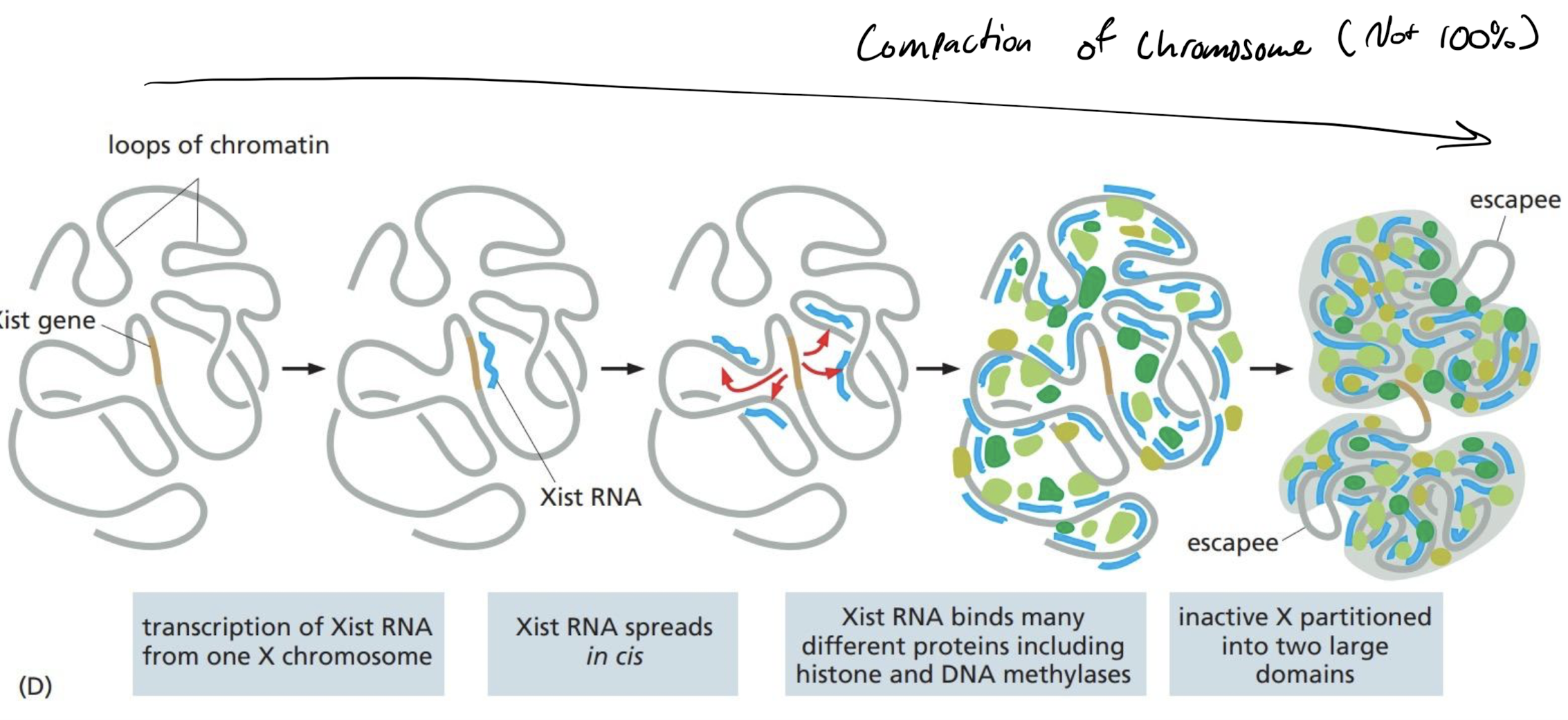
25
New cards
What is RNA interference caused by and what’s its function?
RNA interference is caused by short single-stranded RNAs that selectively bind to the bases of other RNAs in a cell leading to…
* inhibiting its translation
* catalyzing its rapid destruction
* directing the formation of repressive chromatin on its attached DNA template to block further transcription
* inhibiting its translation
* catalyzing its rapid destruction
* directing the formation of repressive chromatin on its attached DNA template to block further transcription

26
New cards
What do miRNAs do?
They base pair to specific RNAs and fine tune their translation and stability
* synthesized by RNA pol II and are 5’ capped and polyadenylated
* used to form RISCs
* synthesized by RNA pol II and are 5’ capped and polyadenylated
* used to form RISCs
27
New cards
What are RISCs and what do they do?
miRNA assembles with a set of proteins to form a RISC
* seek their complementary base-paired mRNA
* if there’s enough of a match, the mRNA is sliced
* if base-pairing between the miRNA and the mRNA is less extensive, translation of the mRNA is repressed by the recruitment of deadenylase enzymes—which shorten the poly-A tail—and other proteins that directly block access of the mRNA to the proteins
* seek their complementary base-paired mRNA
* if there’s enough of a match, the mRNA is sliced
* if base-pairing between the miRNA and the mRNA is less extensive, translation of the mRNA is repressed by the recruitment of deadenylase enzymes—which shorten the poly-A tail—and other proteins that directly block access of the mRNA to the proteins
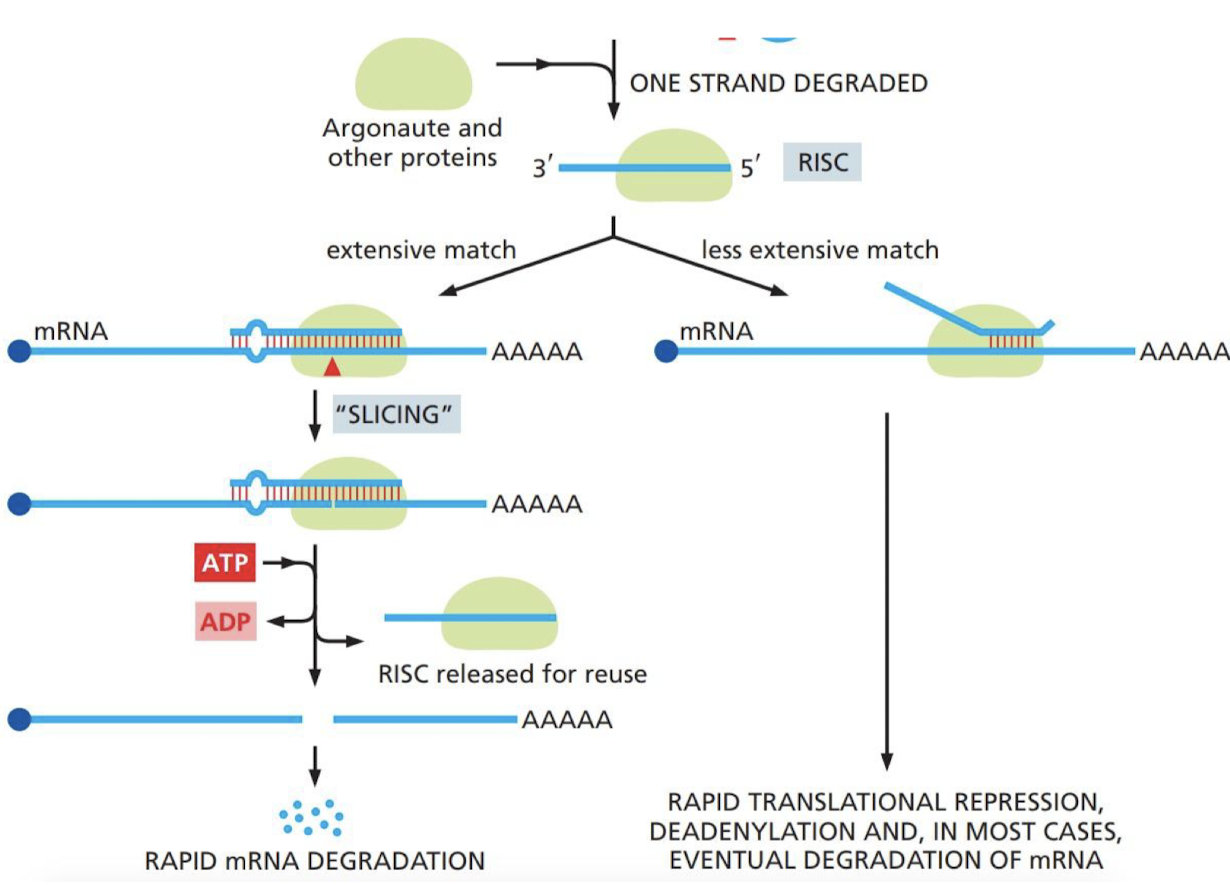
28
New cards
How does RNA interference direct heterochromatin formation?
* short siRNAs produced by the Dicer protein are assembled with a group of proteins to form an RITS (RNA-induced transcriptional silencing) complex.
* Complex binds complementary RNA transcripts as they emerge from a transcribing RNA pol II.
* complex then attracts enzymes that covalently modify nearby histones and DNA causing the formation of a “constitutive” form of heterochromatin.
* Complex binds complementary RNA transcripts as they emerge from a transcribing RNA pol II.
* complex then attracts enzymes that covalently modify nearby histones and DNA causing the formation of a “constitutive” form of heterochromatin.
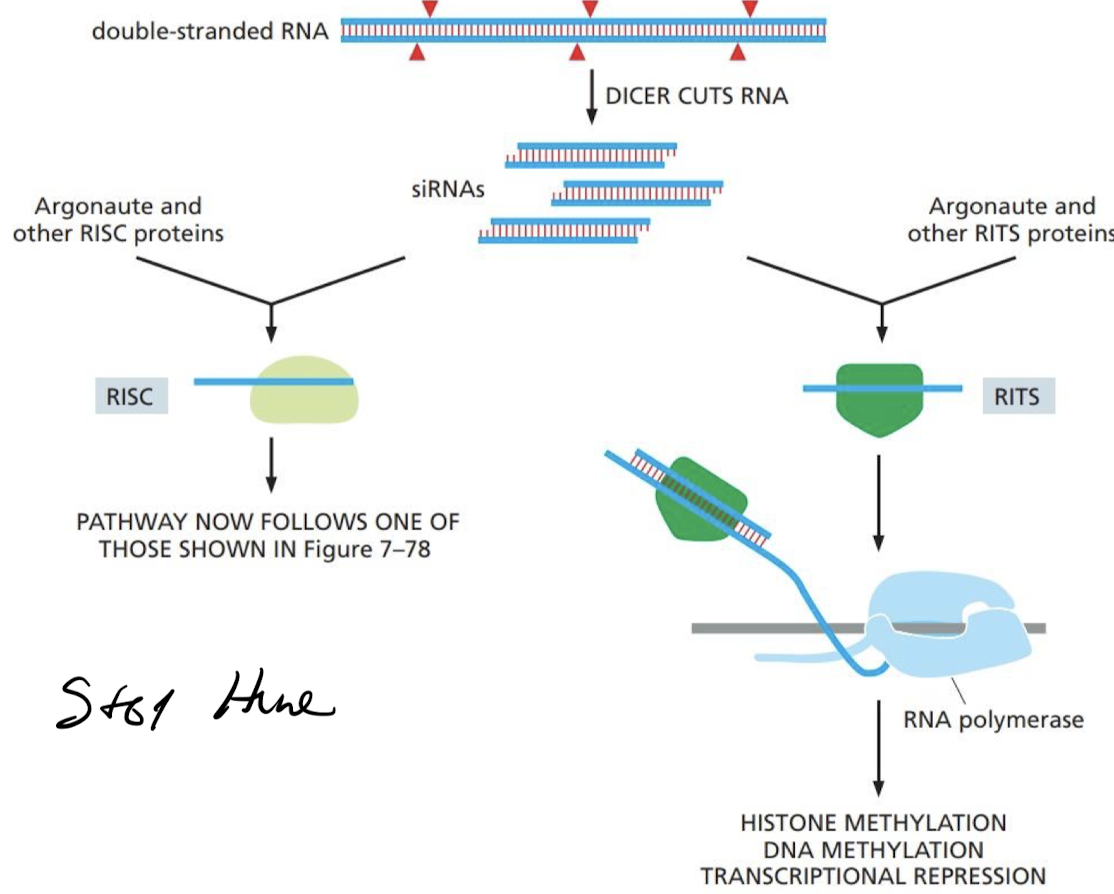
29
New cards
Which of the following does NOT have an effect on the time and place that a certain gene is transcribed in the cell?
A. The type of cis-regulatory sequences associated with it
B. The relative position of cis-regulatory sequences associated with it
C. The arrangement of various cis-regulatory sequences associated with it
D. The specific combination of transcription regulators present in the nucleus
E. The specific combination of transcription regulators present in the cytoplasm
A. The type of cis-regulatory sequences associated with it
B. The relative position of cis-regulatory sequences associated with it
C. The arrangement of various cis-regulatory sequences associated with it
D. The specific combination of transcription regulators present in the nucleus
E. The specific combination of transcription regulators present in the cytoplasm
E. The specific combination of transcription regulators present in the cytoplasm
30
New cards
In mammals, X inactivation occurs when more than one X chromosome is present in a somatic cell. Why does this occur?
A. To cause phenotypic differences between the sexes
B. To avoid nondisjunction of sex chromosomes
C. To allow a higher rate of expression from the active X chromosome
D. To achieve dosage compensation
A. To cause phenotypic differences between the sexes
B. To avoid nondisjunction of sex chromosomes
C. To allow a higher rate of expression from the active X chromosome
D. To achieve dosage compensation
D. To achieve dosage compensation
31
New cards
about ______ of the proteins encoded in an animal’s genome are membrane proteins.
30%
32
New cards
What forces hold together lipids and proteins?
non-covalent interactions
33
New cards
All cell membrane lipids are _______.
amphipathic
* hydrophyllic (polar) heads
* hydrophobic (non-polar) tails
* hydrophyllic (polar) heads
* hydrophobic (non-polar) tails
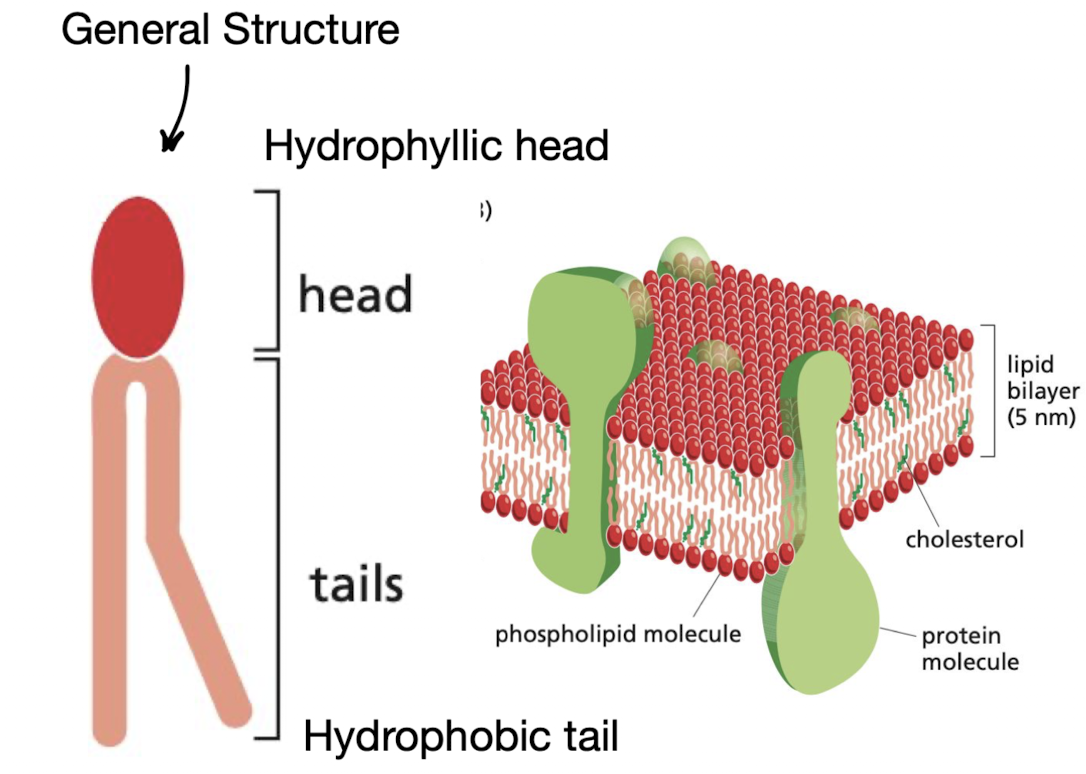
34
New cards
In the fatty acid making up the hydrophobic tail, what is the difference between unsaturated and saturated?
**Unsaturated** = has at least 1 cis-double bond that bends the tail structure
**Saturated** = does not have cis-double bonding
**Saturated** = does not have cis-double bonding

35
New cards
What is the main phospholipid in most animal cell membranes and what is its’ features?
glycerophospholipids
* Three-carbon glycerol backbone
* Two long-chain fatty acids (linked through ester bonds to the glycerol)
* glycerol is attached to a phosphate group (is linked to one of several types of head group)
* Three-carbon glycerol backbone
* Two long-chain fatty acids (linked through ester bonds to the glycerol)
* glycerol is attached to a phosphate group (is linked to one of several types of head group)
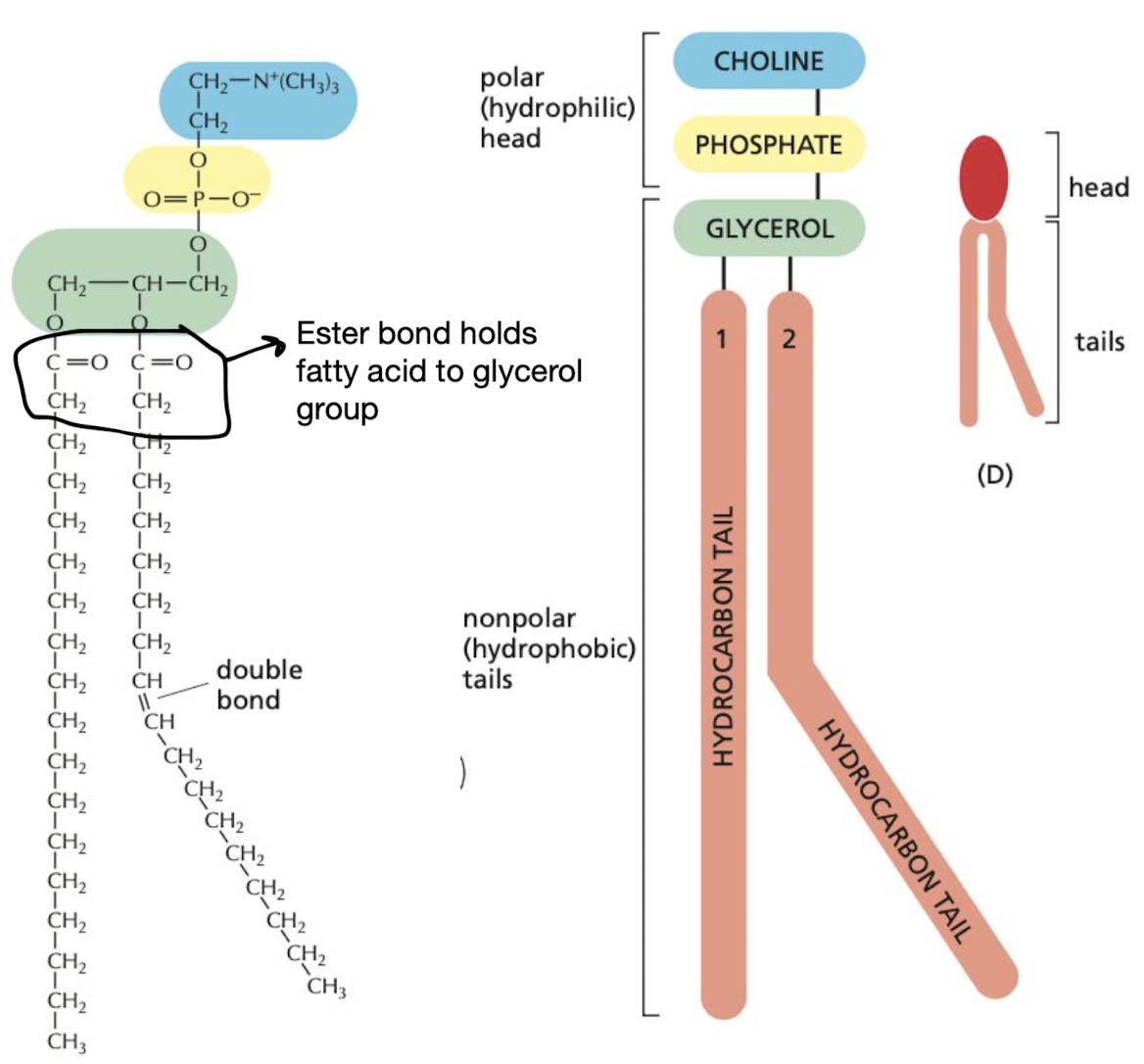
36
New cards
What are sphingolipids and their features?
**sphingolipids** = built from sphingosine rather than glycerol
* has long fatty acid tail with amino (NH) group and two hydroxy (OH) groups
* has long fatty acid tail with amino (NH) group and two hydroxy (OH) groups
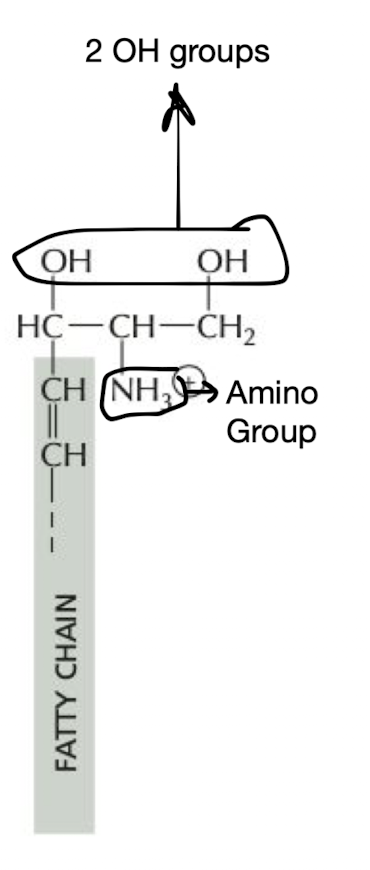
37
New cards
What are glycolipids and their features?
**Glycolipids** = resembles sphingolipids, but have sugars attached
* found exclusively in monolayer **facing away from cytosol** (inside organelles and outside of cell)
* made of sphingosine in animals
* help protect membrane against harsh conditions, cell-recognition, and electrical charge
* found exclusively in monolayer **facing away from cytosol** (inside organelles and outside of cell)
* made of sphingosine in animals
* help protect membrane against harsh conditions, cell-recognition, and electrical charge
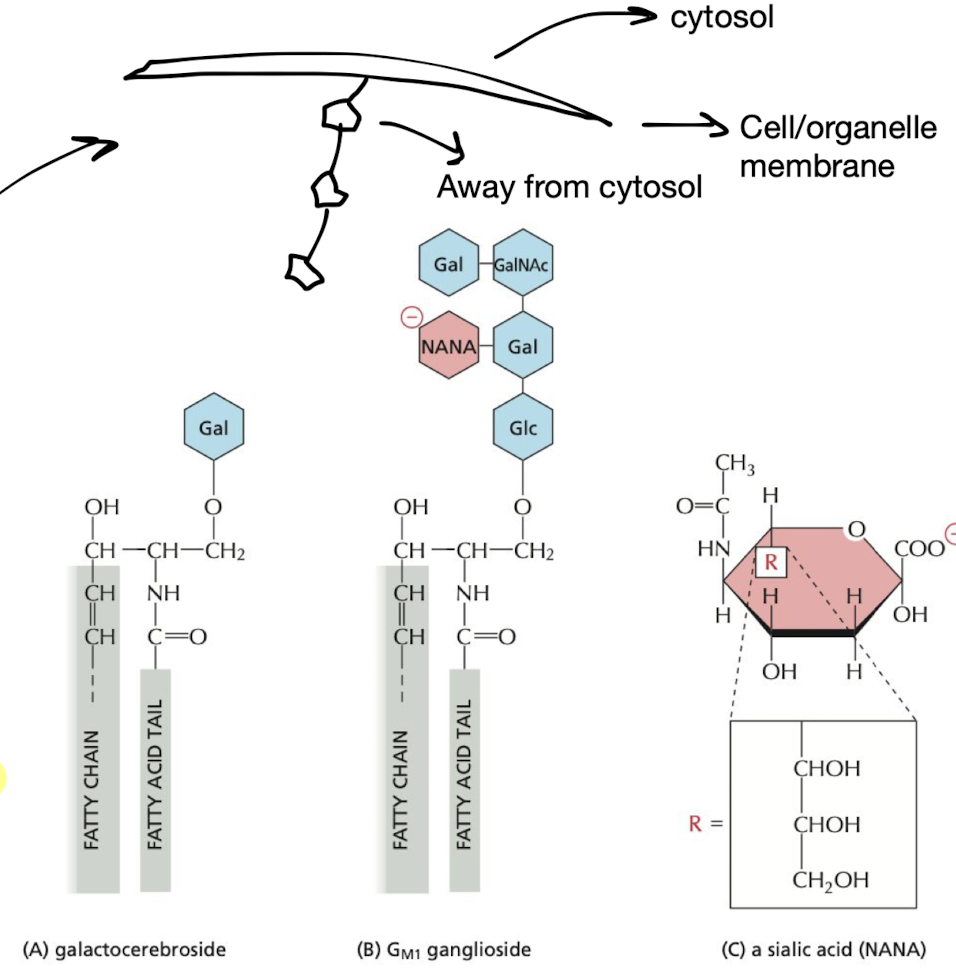
38
New cards
What are sterols and what is their function in the cell membrane?
Rigid ring structures related to steroids but containing a single polar hydroxyl group and a short nonpolar hydrocarbon chain.
* act as a buffer, maintain fluidity of membrane
* mainly found in animals
* cholesterol = main sterol in animals
* act as a buffer, maintain fluidity of membrane
* mainly found in animals
* cholesterol = main sterol in animals
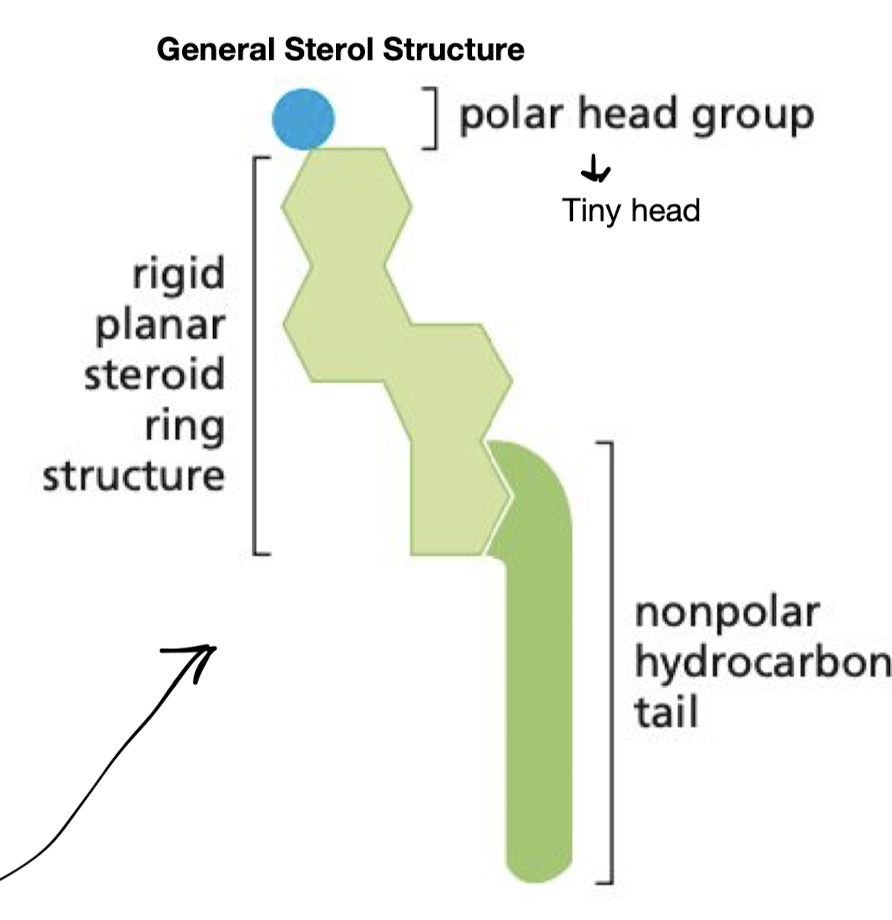
39
New cards
Why do hydrophilic molecules dissolve in water?
because they contain charged or uncharged polar groups that can form either favorable electrostatic interactions or hydrogen bonds with water molecules
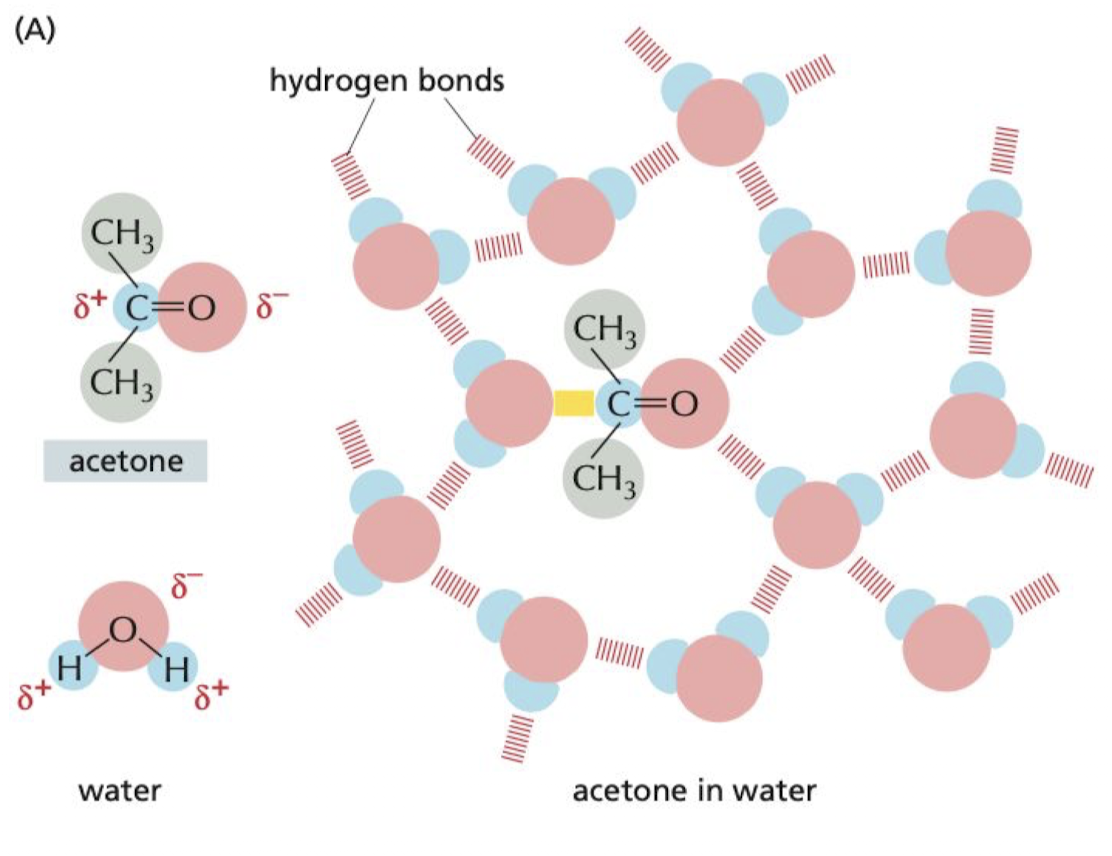
40
New cards
Why are hydrophobic molecules insoluble in water?
because all, or almost all, of their atoms are uncharged and nonpolar and therefore cannot form energetically favorable interactions with water molecules.
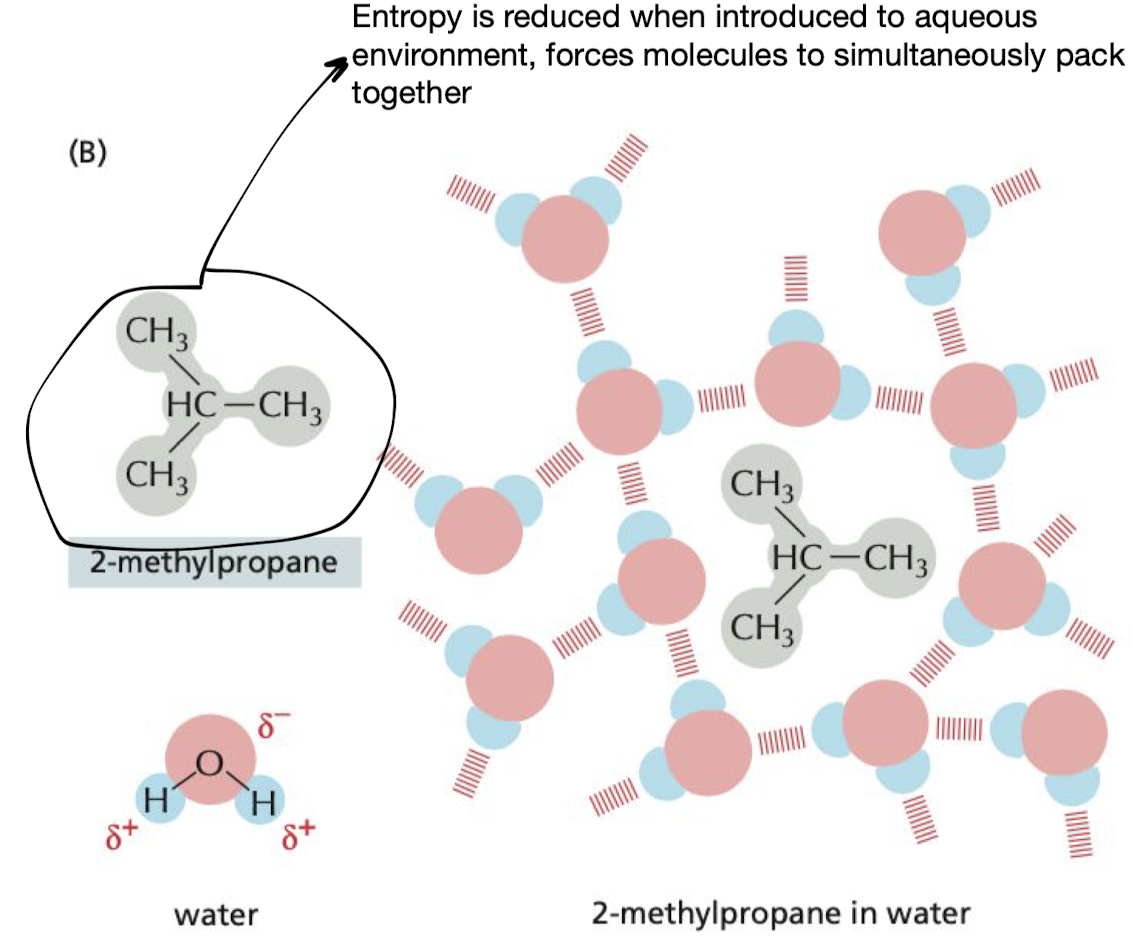
41
New cards
What causes lipids to spontaneously form bilayers?
* The ordering of water molecules around hydrophobic molecules increases the entropy of the system (not favorable).
* To minimize the number of water molecules affected, **hydrophobic molecules cluster together in aqueous environment. to…**
* To minimize the number of water molecules affected, **hydrophobic molecules cluster together in aqueous environment. to…**
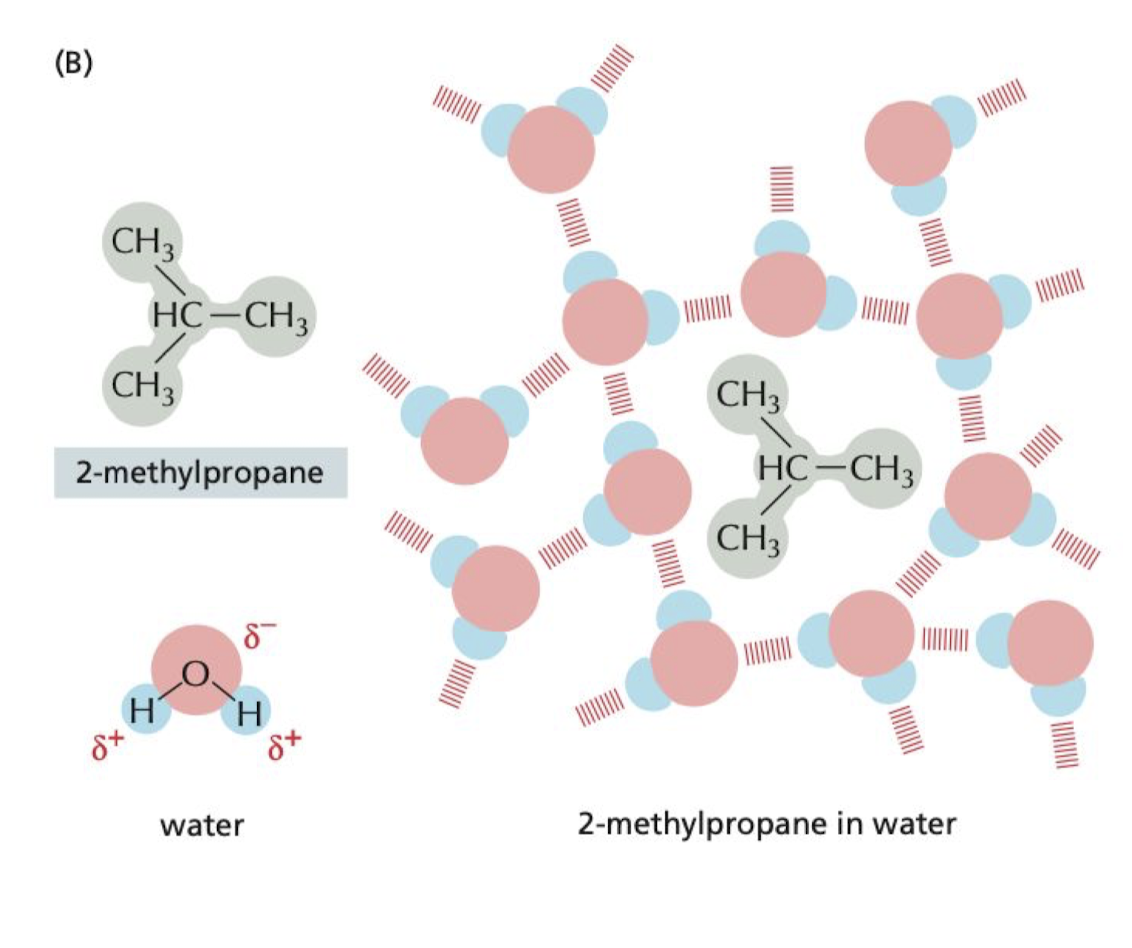
42
New cards
How do lipid molecules organize themselves spontaneously to pack together?
* minimize exposure of their hydrophobic tails to water
* maximize exposure of their hydrophilic heads to water.
* maximize exposure of their hydrophilic heads to water.
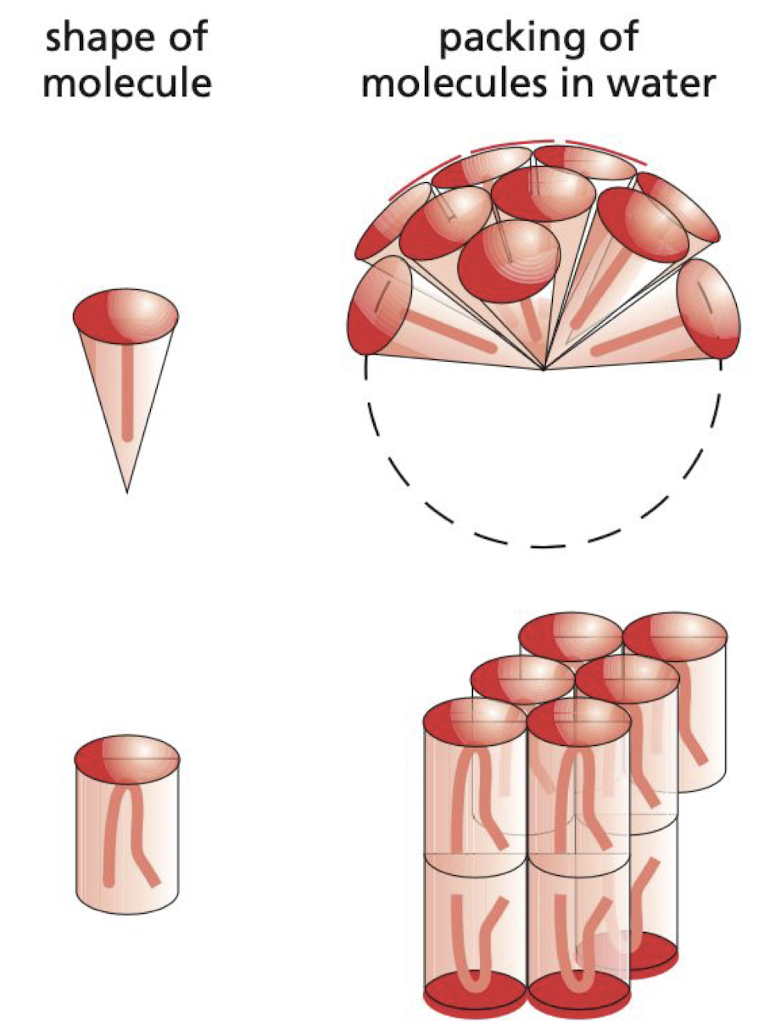
43
New cards
What are the two forms of bilayers and what molecules make them up?
**Spherical micelles**
* formed by cone-shaped amphiphilic molecules with one hydrophobic tails
**Double layered sheets**
* classic lipid bilayer shape, formed by cylindrical amphiphilic molecules with two hydrophobic tails
* formed by cone-shaped amphiphilic molecules with one hydrophobic tails
**Double layered sheets**
* classic lipid bilayer shape, formed by cylindrical amphiphilic molecules with two hydrophobic tails
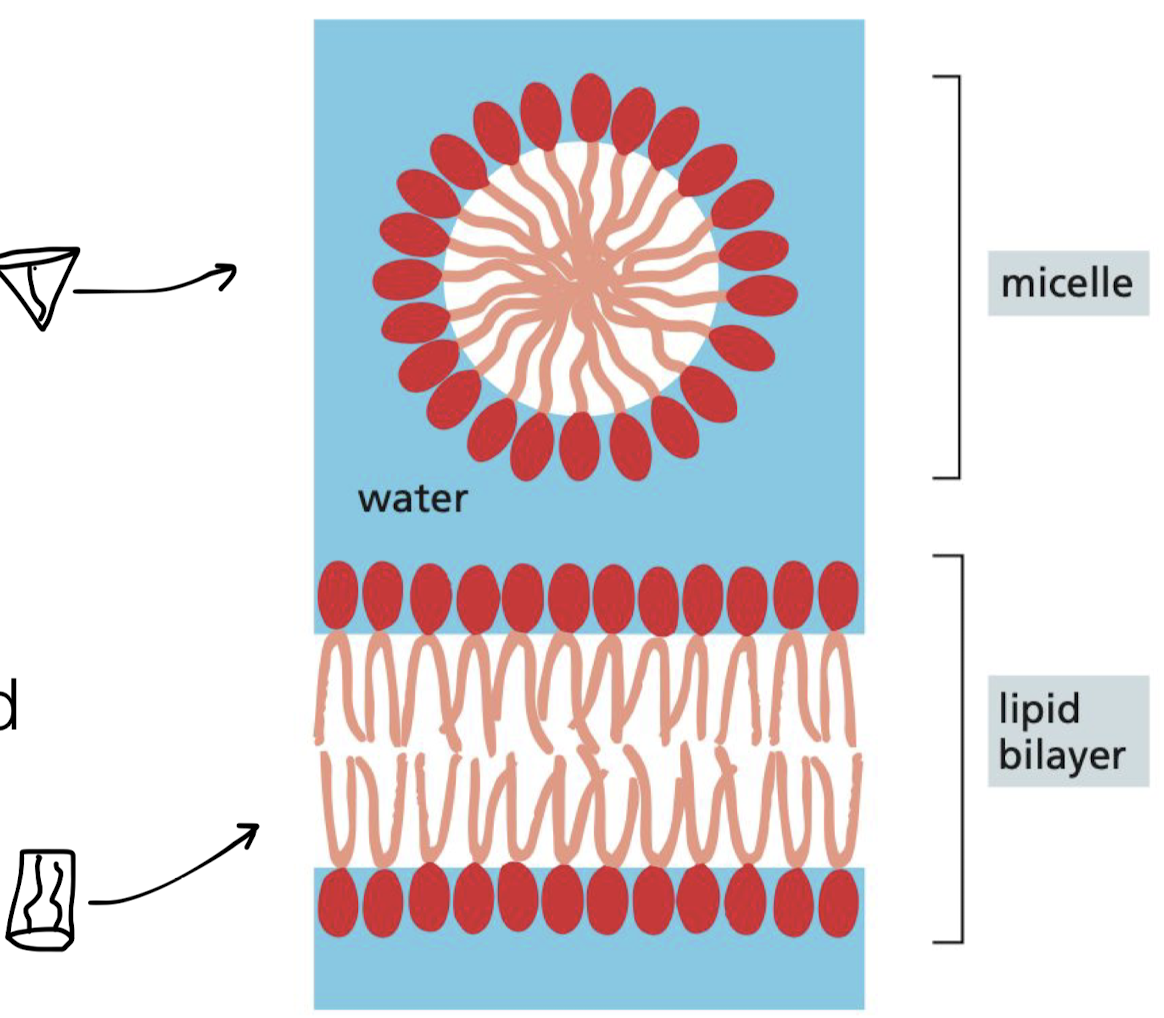
44
New cards
How do bilayers avoid having edges?
they close in on themselves forming a sealed compartment
* idea behind how cells originally formed
* idea behind how cells originally formed
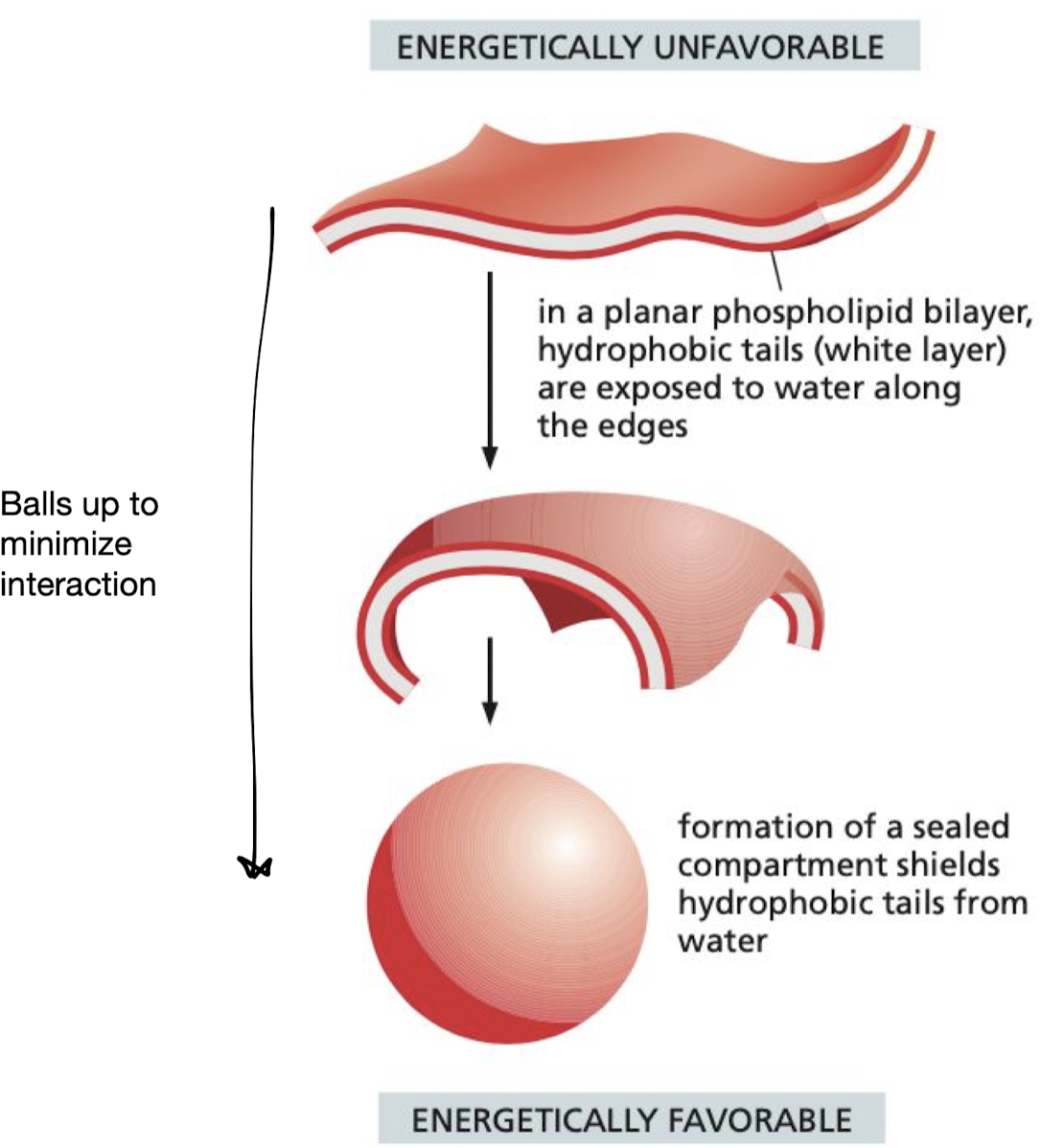
45
New cards
What are the different ways that lipids can move within the bilayer?
1. flexion
2. lateral diffusion
3. flip-flops (rare)
4. rotation
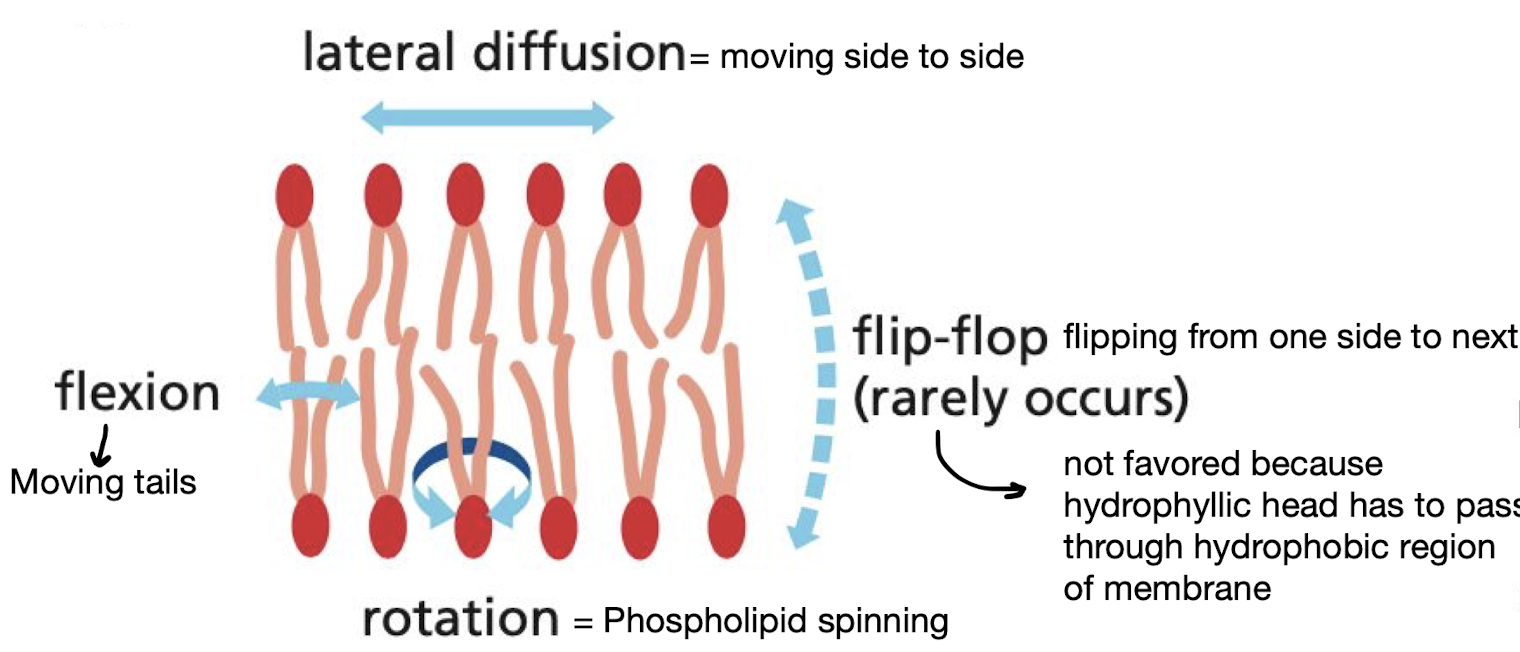
46
New cards
Why is the asymmetry of the lipid bilayer important for cell function?
1. **Creates a difference in charge** between one side of the membrane by confiding phosphatidylserine in inner layer of membrane
2. **Converting extracellular messages to intracellular**
3. **Distinguish between live and dead cells**
1. presence of phosphatidylserine on outside of cell indicates cellular death
47
New cards
What are transmembrane proteins?
Membrane proteins extending through the entire lipid bilayer
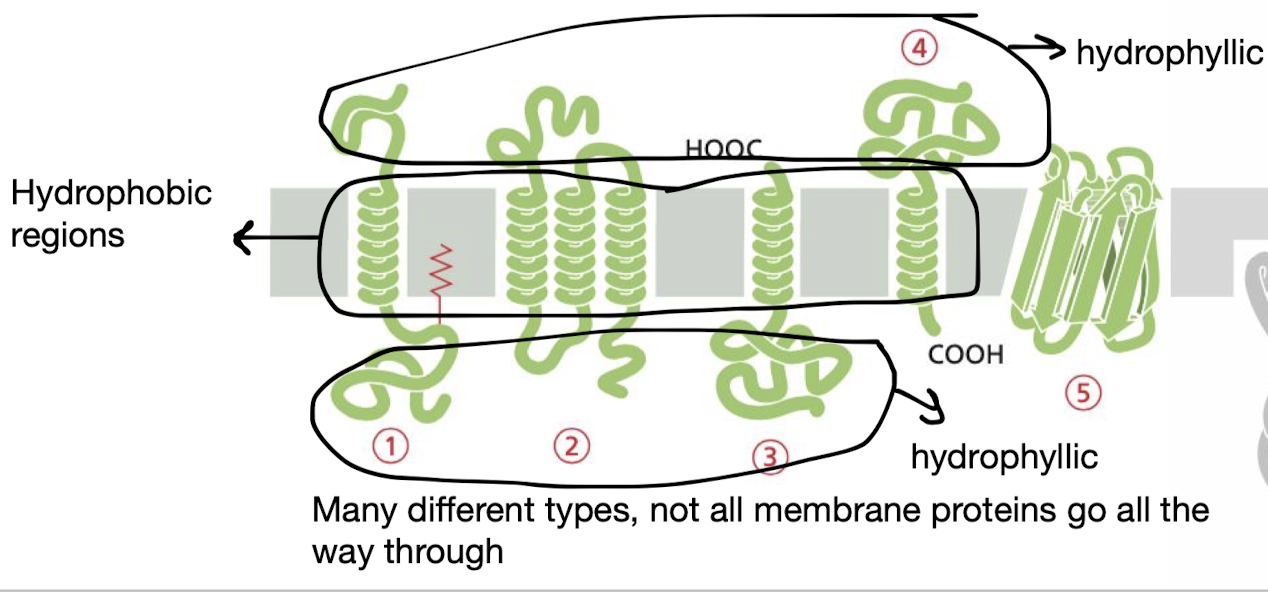
48
New cards
What are cystolic monolayer anchored proteins?
Proteins attached to cystolic (facing inside of cell) either by an amphiphilic alpha helix exposed on the surface of the protein or by one or more covalently attached lipid chains.
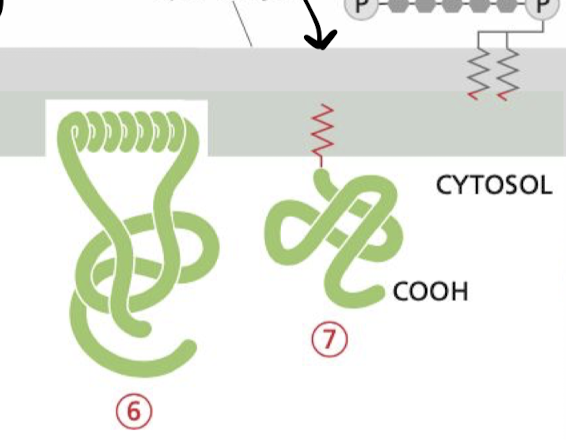
49
New cards
What are extracellular monolayer proteins?
Proteins entirely exposed at external cellular surface
* attached only by a covalent linkage to a lipid anchor on the outer monolayer
* attached only by a covalent linkage to a lipid anchor on the outer monolayer
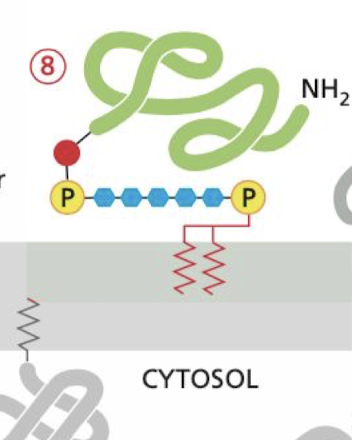
50
New cards
What are membrane-associated proteins?
**Proteins bonded to other proteins** on the external/internal monolayer, can easily dissociate → not as strong of a bond
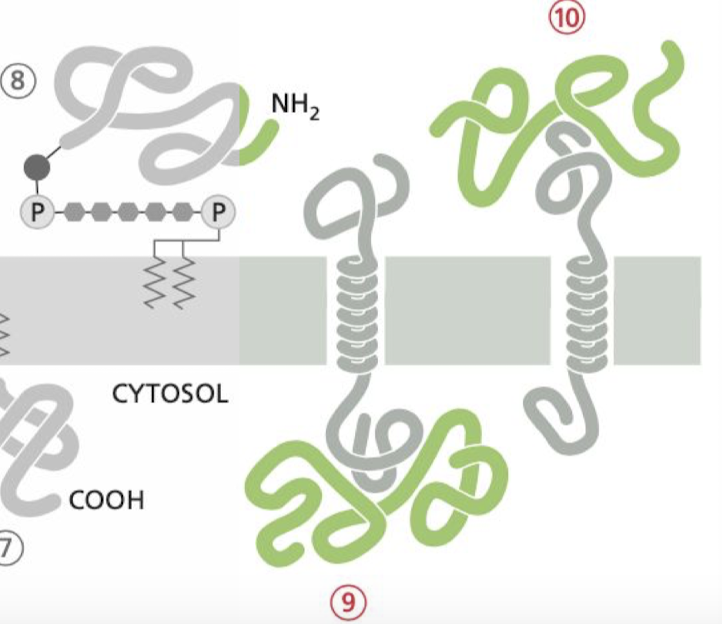
51
New cards
True or False: transmembrane alpha helices can interact with each other.
True. proteins can interact with each other via strong non-covalent forces to form channels that allow for many important cellular processes

52
New cards
Do beta barrels arrange the same way as alpha helices in the cellular membrane?
No. Beta barrel membrane proteins form together only as a cylinder.
* size and shape is highly variable to allow certain hydrophilic molecules to enter/exit the cell
* size and shape is highly variable to allow certain hydrophilic molecules to enter/exit the cell

53
New cards
What does it mean when a membrane protein is glycosylated?
It means the protein is coated with oligosaccharide and polysaccharide chains facing the outside of the cell → bound to membrane proteins and lipids
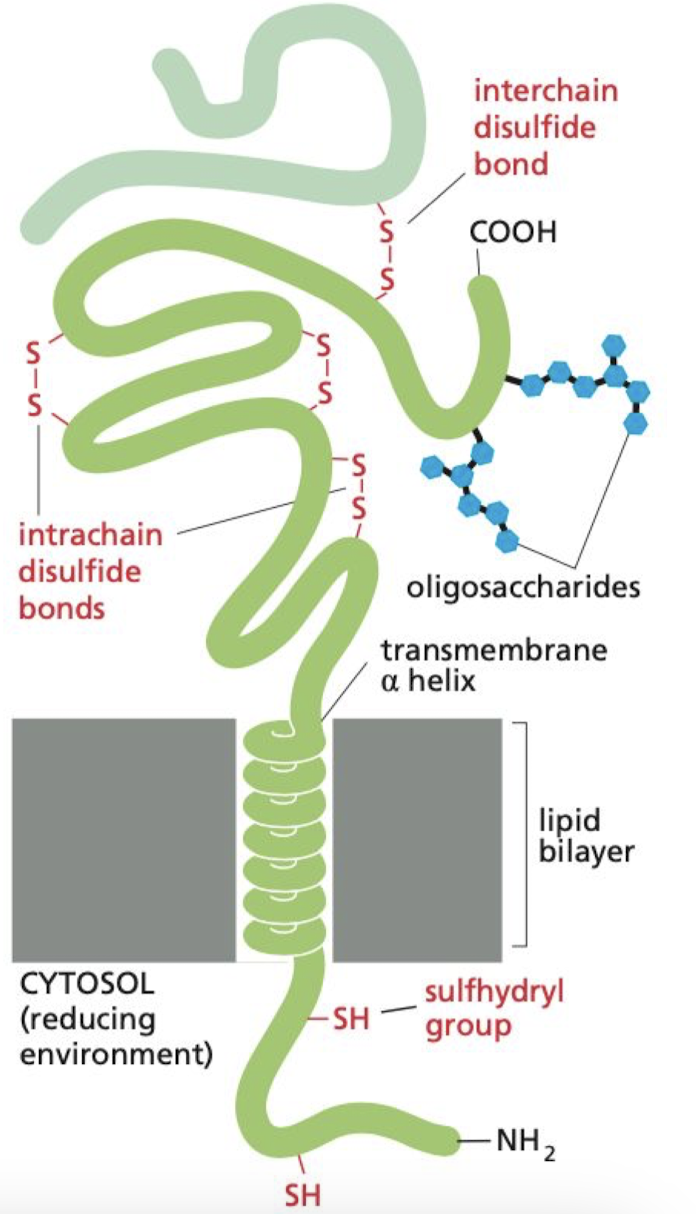
54
New cards
What is the name for carbohydrate-rich zones on the cell surface and what is their function?
cell coat / glycocalyx
* function is to protect against mechanical and chemical damage, prevents unwanted cell-cell interactions
* function is to protect against mechanical and chemical damage, prevents unwanted cell-cell interactions
55
New cards
What are detergents?
small amphipathic molecules that can disrupt hydrophobic associations and disassemble the lipid bilayer
* also have one hydrophobic and one hydrophilic side → similar to lipids
* also have one hydrophobic and one hydrophilic side → similar to lipids
56
New cards
How do detergents break down lipid bilayers?
hydrophobic ends of detergents attach to the hydrophobic parts of membrane proteins, pushing out lipid molecules and forming a collar of detergent molecules. Since the other end of the detergent is polar, this interaction helps dissolve the membrane proteins in solution, forming detergent-protein complexes.

57
New cards
How does membrane diffusion help maintain membrane fluidity?
if a certain portion of the bilayer is modified, membrane lipids diffuse to even out modified area.
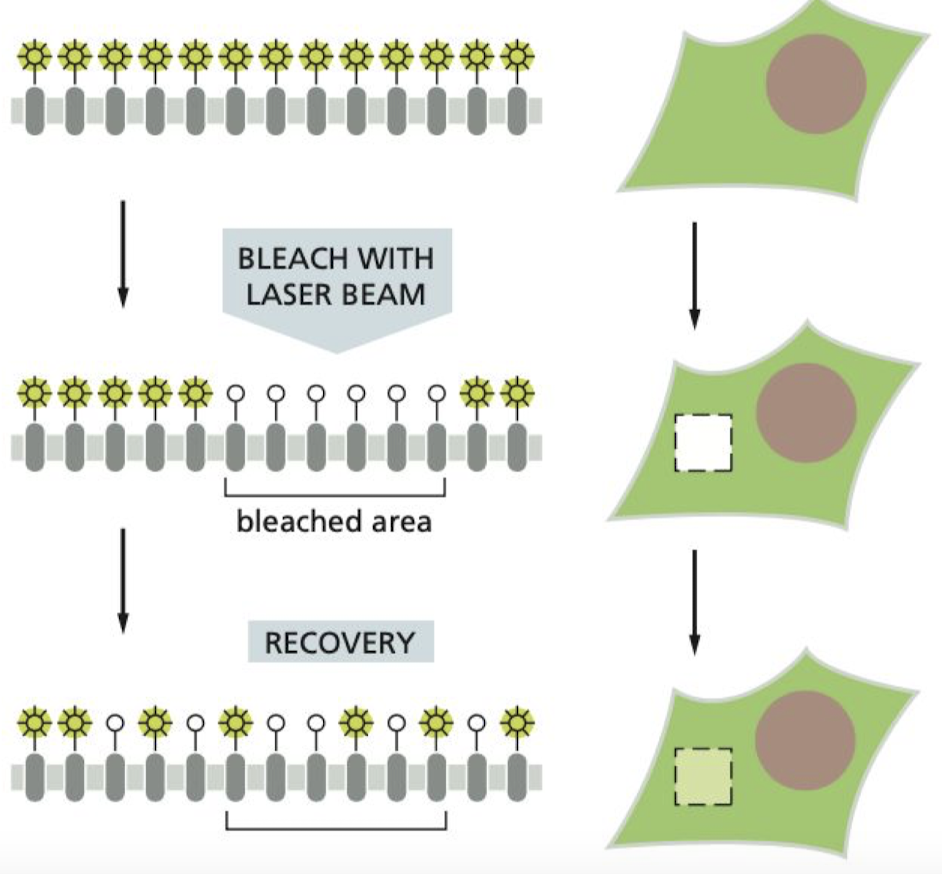
58
New cards
What stops the diffusion of lipids and protein molecules between cells?
**epithelial cells**
* Enzymes on the plasma membrane are found either on the top surface (apical) or on the bottom and side surfaces (basal and lateral) of cells. Additionally, the lipid compositions of these two areas of the membrane are different
* The barriers set up by a specific type of intercellular junction (called a tight junction)
* Enzymes on the plasma membrane are found either on the top surface (apical) or on the bottom and side surfaces (basal and lateral) of cells. Additionally, the lipid compositions of these two areas of the membrane are different
* The barriers set up by a specific type of intercellular junction (called a tight junction)

59
New cards
What are the 4 ways that plasma membrane proteins’ lateral movement is restricted?
A. proteins can self-assemble into large aggregates
B. they can be tethered by interactions with assemblies of macromolecules inside the cell
C. they can be tethered by interactions with assemblies of macromolecules outside the cell
D. interact with proteins on the surface of another cell
B. they can be tethered by interactions with assemblies of macromolecules inside the cell
C. they can be tethered by interactions with assemblies of macromolecules outside the cell
D. interact with proteins on the surface of another cell
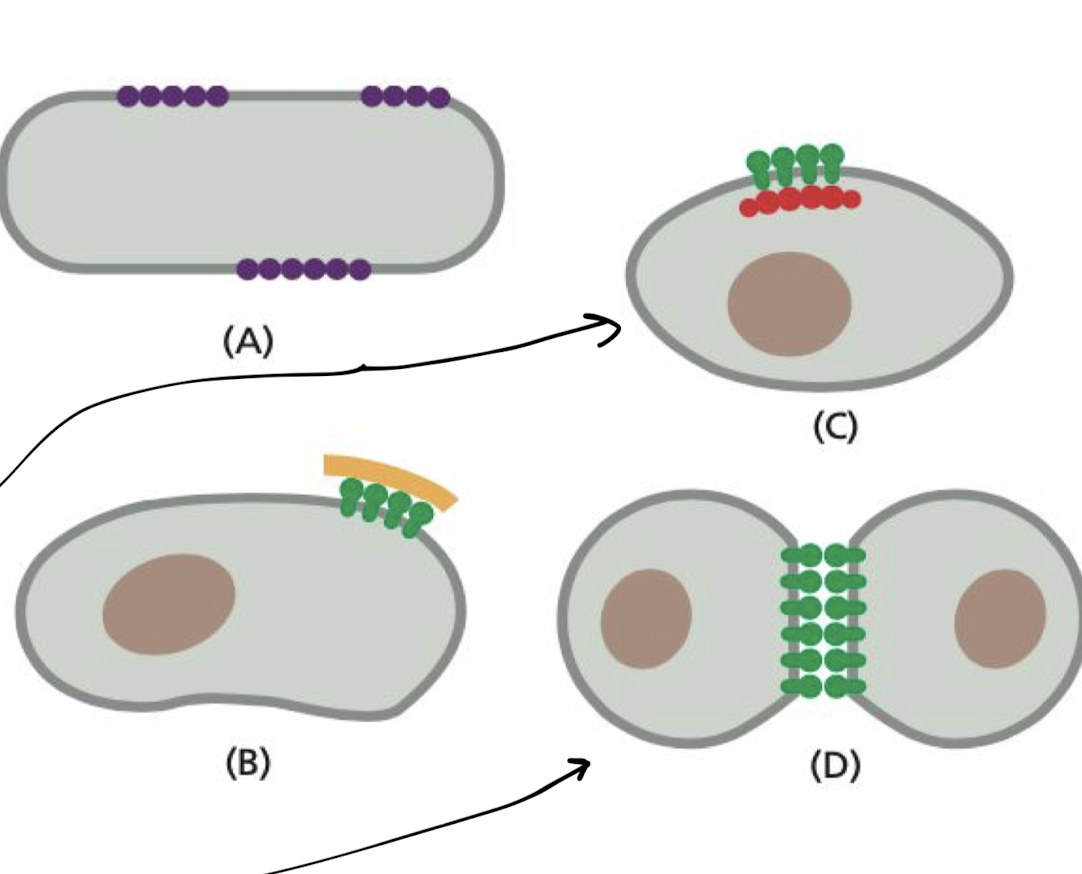
60
New cards
What are the 3 ways that membrane-bending proteins deform the lipid bilayer?
1. **Insertion of hydrophobic protein domains** or attached lipid anchors into leaflets of lipid bilayer → increasing area of one leaflet bends protein
2. **Forming rigid scaffolds to deform the membrane** / support already bent membrane
3. **Manipulation of specific lipids** strategically bends the proteins

61
New cards
Which of the following is NOT correct regarding the molecule whose structural formula is shown below? A. It is an amphiphilic molecule.
B. It is a sterol.
C. It makes the membrane less permeable to small hydrophilic molecules.
D. It is found in membranes of virtually all living cells.
E. It affects the fluidity of the lipid bilayer.
B. It is a sterol.
C. It makes the membrane less permeable to small hydrophilic molecules.
D. It is found in membranes of virtually all living cells.
E. It affects the fluidity of the lipid bilayer.
D. It is found in membranes of virtually all living cells.
62
New cards
Which of the following is NOT a function of a glycolipid?
A. Protect the cell against degradative enzymes
B. Participate in the cell recognition process
C. Protect the cell against low pH
D. Alter the electrical field across the plasma membrane
E. Assist in solubility of proteins near the plasma membrane in the cytosol
A. Protect the cell against degradative enzymes
B. Participate in the cell recognition process
C. Protect the cell against low pH
D. Alter the electrical field across the plasma membrane
E. Assist in solubility of proteins near the plasma membrane in the cytosol
E. Assist in solubility of proteins near the plasma membrane in the cytosol
63
New cards
What 2 factors impact the rate of diffusion of molecules across membranes?
1. Size → the smaller the molecule, the easier it diffuses
2. Hydrophobicity → the more hydrophobic/nonpolar the molecule is, the easier it will diffuse across
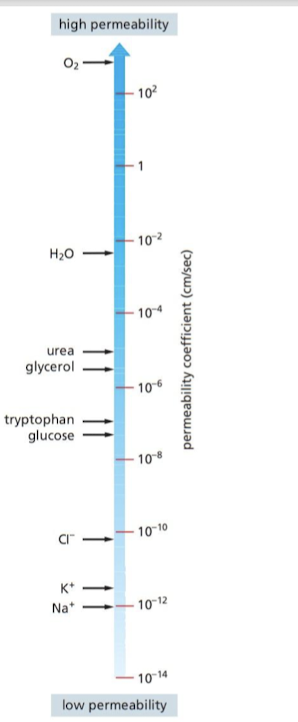
64
New cards
What are the two main classes of membrane transport proteins?
1. Transporters
2. Channels
Each one often transports specific molecular species/class
65
New cards
What are transporter transport proteins?
Transport proteins that undergoes conformational change to expose solute-binding site to transport target molecule
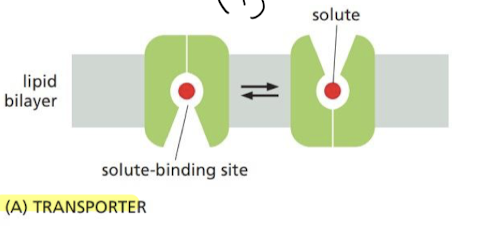
66
New cards
What are channel transport proteins?
transport proteins that form **continuous pores** extending across lipid bilayer, allowing solutes to pass through them.
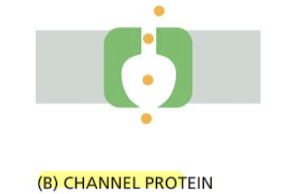
67
New cards
What is passive transport?
Transportation of molecules **down** the concentration or electrochemical gradient without the need for energy
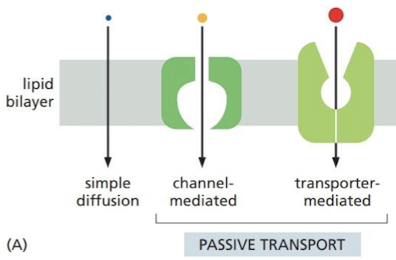
68
New cards
What is active transport?
Movement of solute **against** its concentration or electrochemical gradient using energy
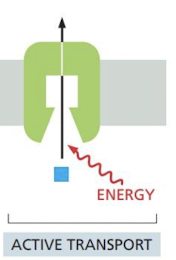
69
New cards
The inside of cells tend to be ______ charged.
Negatively
70
New cards
What are the three ways that **active transport** is carried out?
1. Coupled transport
2. ATP-driven pumps
3. Light-driven pumps
71
New cards
What is coupled active transport?
transportation of target molecule **against** its concentration gradient is powered by the transport of another molecule **down** its concentration gradient.
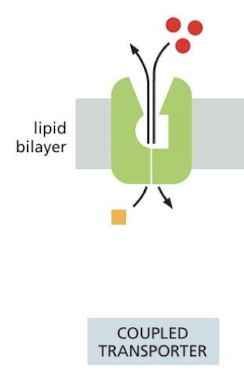
72
New cards
What are ATP-driven pumps?
hydrolyzation of ATP to push molecule against concentration gradient → classic example
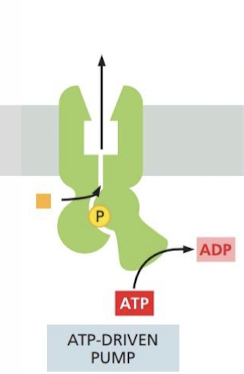
73
New cards
What are light-driven pumps?
uses energy of light to push molecule against concentration gradient
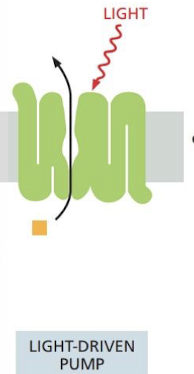
74
New cards
What are uniporters?
transporters that allow for the passive transport of a single molecule.
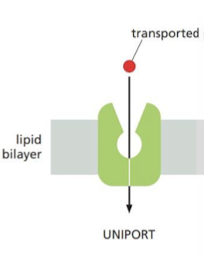
75
New cards
What is are the two types of coupled transporters?
1. **Symporters** → couple transfer of second molecule in the same direction
2. **Antiporters** → couple transfer of second molecule in opposite direction
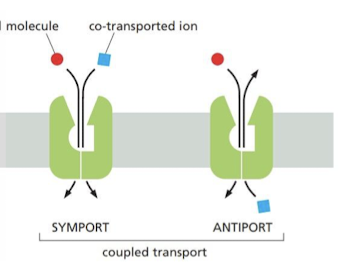
76
New cards
How do transporters in epithelial cells help with transcellular transport?
The transporters create a bridge allowing molecules to move across epithelial cell layer into extracellular fluid
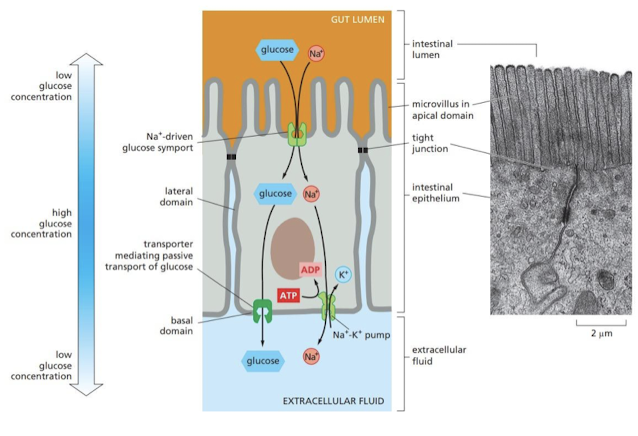
77
New cards
What are the 3 classes of ATP-driven pumps?
1. P-type pumps
2. ABC transporters
3. V-type pumps
78
New cards
What are P-type pumps and what is their main function?
They phosphorylate themselves during the pumping cycle to push molecules against their gradient
* many ion pumps are in this category
* many ion pumps are in this category

79
New cards
What are ABC transporters and what’s their usual function?
ABC transporters = ATP-binding casette transporters
* mainly pump small organing molecules across membrane
* mainly pump small organing molecules across membrane
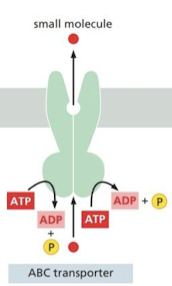
80
New cards
What are V-type pumps and what is their function?
Pumps made up of different subunits
* transfers H+ into organelles
* transfers H+ into organelles
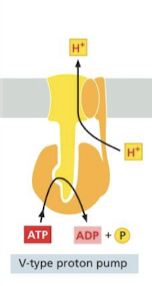
81
New cards
What are F-type ATPases (AKA ATP Synthase)?
use H+ gradient across membrane to drive syntehsis of ATP from ADP and P
* found in bacteria and mitochondria
* found in bacteria and mitochondria
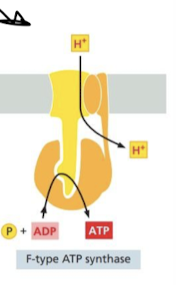
82
New cards
What is the function of P-type ATPase in the sarcoplasmic reticulum (SR)?
to pump Ca2+ into the SR so it can act as storage for them
83
New cards
What does the ion exchange look like in a Na+/K+ pump?
3 NA+ lost, 2K+ gained
* electrogenic → drives net current acrosss membrane
* electrogenic → drives net current acrosss membrane
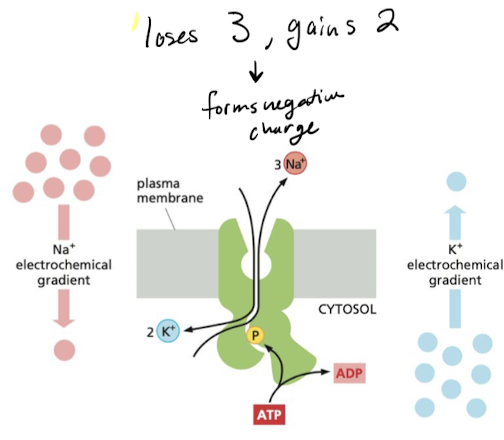
84
New cards
What are aquaporin channels and how do they work?
pores that allow water to move rapidly in and out of cells
* disallow ions
* allow single water molecules to pass through, too narrow for hydrated ion
* two asparagines bind to O atom of H2O to pull string of water molecules
* disallow ions
* allow single water molecules to pass through, too narrow for hydrated ion
* two asparagines bind to O atom of H2O to pull string of water molecules
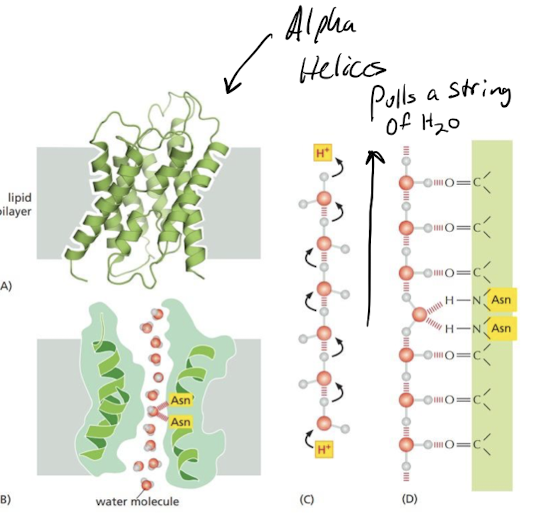
85
New cards
What is the **selectivity filter**?
filter that limits a channel’s rate of ion movement.
* determines which ions can pass → gated
* determines which ions can pass → gated
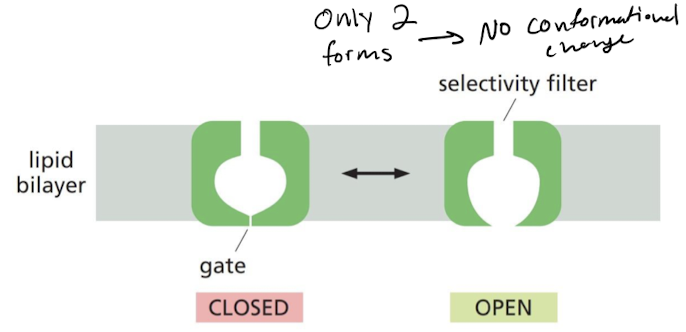
86
New cards
What are the 3 main types of stimuli that open ion channels?
1. change in voltage (voltage-gated)
2. mechanical stress (mechanically-gated)
3. ligand binding (ligand-gated)
87
New cards
How do voltage-gated channels generate action potentials?
K+ channels depolarize and Na+ depolarize with a refractory period that restricts backflow of the signal. this allows for the signal to propagate down the axon of neurons.
88
New cards
Why do cells not have membrane transport proteins for O2?
a. Because they need to keep the oxygen concentration low inside the reducing environment of the cell
b. Because oxygen can dissolve in water and leak in via water channels
c. Because oxygen can dissolve in the lipid bilayer and diffuse in and out rapidly without the need for a transporter
d. Because oxygen is transported in and out of the cell in special oxygen-carrying proteins such as hemoglobin e. Because oxygen transport across a membrane is energetically unfavorable
a. Because they need to keep the oxygen concentration low inside the reducing environment of the cell
b. Because oxygen can dissolve in water and leak in via water channels
c. Because oxygen can dissolve in the lipid bilayer and diffuse in and out rapidly without the need for a transporter
d. Because oxygen is transported in and out of the cell in special oxygen-carrying proteins such as hemoglobin e. Because oxygen transport across a membrane is energetically unfavorable
c. Because oxygen can dissolve in the lipid bilayer and diffuse in and out rapidly without the need for a transporter
89
New cards
Aquaporin has a pair of key asparagine residues located on the wall almost halfway through its pore. These residues simultaneously bind to the oxygen atom of a passing water molecule, rendering it unavailable for hydrogen bonding. As a result, what happens?
a. The channel can conduct negatively charged (but not positively charged) ions.
b. The channel can conduct glycerol as well as water.
c. The channel cannot conduct glycerol.
d. The channel cannot conduct protons.
e. The channel cannot conduct chloride ions.
a. The channel can conduct negatively charged (but not positively charged) ions.
b. The channel can conduct glycerol as well as water.
c. The channel cannot conduct glycerol.
d. The channel cannot conduct protons.
e. The channel cannot conduct chloride ions.
d. The channel cannot conduct protons.
90
New cards
What are the 2 functional importances of organelles?
1. providing increased membrane area for biochemical RX
2. creating functionally specialized spaces within cell
91
New cards
What is the function of the endoplasmic recticulum (ER)?
* assembles soluble and integral membrane proteins for cell exterior/ organelles
* produces most cellular lipids and sterols
* acts as storage for Ca2+ ions
\
* produces most cellular lipids and sterols
* acts as storage for Ca2+ ions
\
92
New cards
What is the function of the golgi apparatus?
receives lipids and proteins from ER, packages them to various destinations
93
New cards
What is the functions of lysosomes?
uses digestive enzymes to degrade intracellular organelles and particles taken in from outside the cell
94
New cards
What is the function of peroxisomes?
contain enzymes to carryout oxidative reactions
95
New cards
What percentage of the cell is organelles? cytosol?
50-50
96
New cards
What was the timeline for how ancestral cells acquired organelles?
1. the ancestral cells might have initially increased by plasma membrane protrusions to increase the capacity to metabolites exchange with the environment
2. Symbioses and membrane expansion increased resource availability allowed cells to grow larger.
3. the network of spaces between protrusions would have become sealed off from the surrounding environment.

97
New cards
What are the 4 ways that proteins can move between compartments in the cell?
1. Protein translocation
2. gated transport
3. vesicular transport
4. engulfment
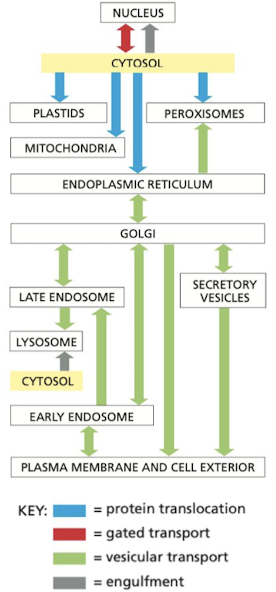
98
New cards
What is protein translocation?
transmembrane protein translocators directly transport specific proteins from cytosol into space that is topologically distinct
99
New cards
What is gated transport?
proteins and RNA molecules move b/w cytosol and nucleus through nuclear pore complexes
100
New cards
What is vesicular transport?
membrane-enclosed transport that ferries proteins from one compartment to another
